Sony MDS-JB920 User Manual
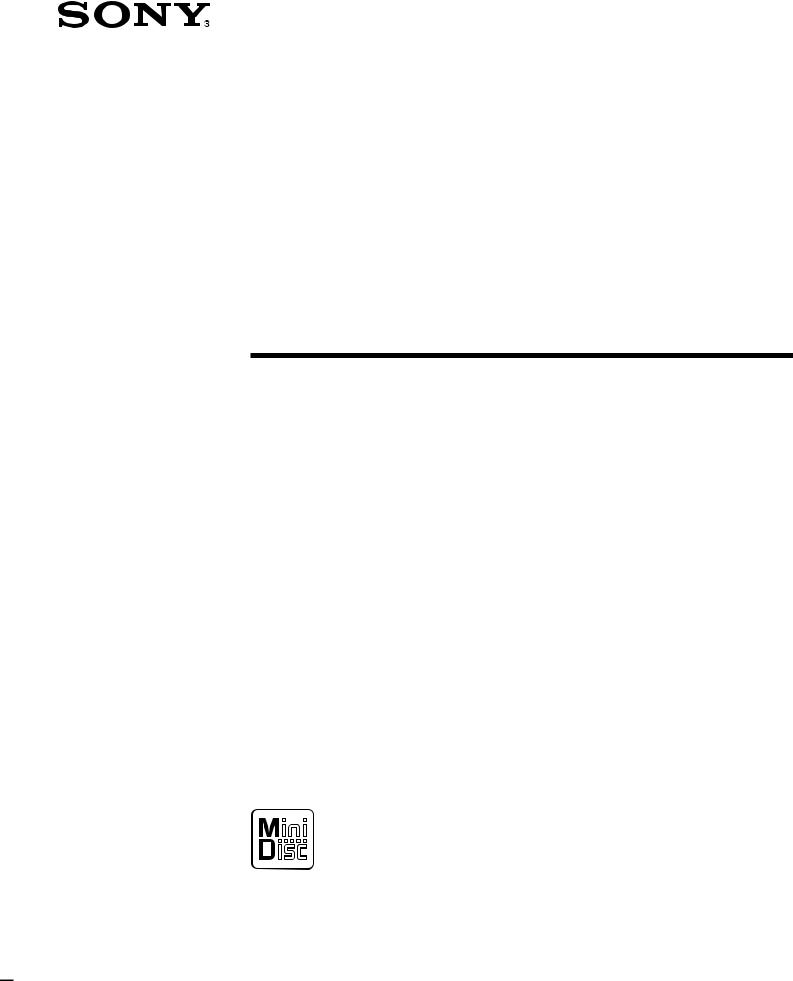
3-864-150-11(1)
MiniDisc Deck
Operating Instructions |
EN |
||
|
|
|
|
Mode d’emploi |
|
F |
|
MDS-JB920
ã 1998 by Sony Corporation
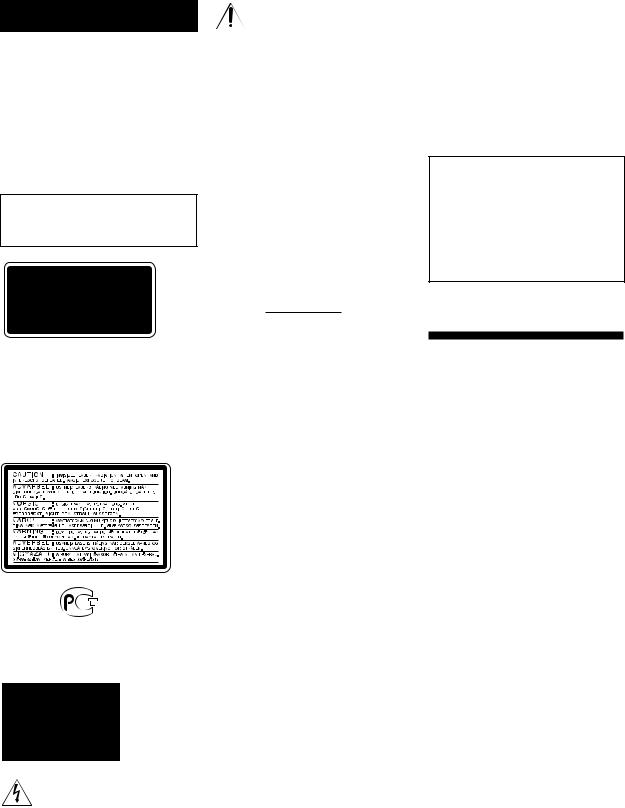
WARNING
To prevent fire or shock hazard, do not expose the unit to rain or moisture.
To avoid electrical shock, do not open the cabinet. Refer servicing to qualified personnel only.
The laser component in this product is capable of emitting radiation exceeding the limit for Class 1.
This appliance is classified as a CLASS 1 LASER product. The CLASS 1 LASER PRODUCT MARKING is located on the rear exterior.
The following caution label is located inside of the unit.
For the customers in the United States
This symbol is intended to alert the user to the presence of uninsulated “dangerous voltage” within the product’s enclosure that may be of sufficient magnitude to constitute a risk of electric shock to persons.
This symbol is intended to alert the user to the presence of important operating and maintenance (servicing) instructions in the literature accompanying the appliance.
CAUTION
The use of optical instruments with this product will increase eye hazard.
Owner’s Record
The model and serial numbers are located on the rear of the unit. Record these numbers in the spaces provided below. Refer to them whenever you call upon your Sony dealer regarding this product.
Model No. MDS-JB920
Serial No.
INFORMATION
This equipment has been tested and found to comply with the limits for a Class B digital device, pursuant to Part 15 of the FCC Rules.
These limits are designed to provide reasonable protection against harmful interference in a residential installation. This equipment generates, uses, and can radiate radio frequency energy and, if not installed and used in accordance with the instructions, may cause harmful interference to radio communications. However, there is no guarantee that interference will not occur in a particular installation. If this equipment does cause harmful interference to radio or television reception, which can be determined by turning the equipment off and on, the user is encouraged to try to correct the interference by one or more of the following measures:
–Reorient or relocate the receiving antenna.
–Increase the separation between the equipment and receiver.
–Connect the equipment into an outlet on a circuit different from that to which the receiver is connected.
–Consult the dealer or an experienced radio/TV technician for help.
CAUTION
You are cautioned that any changes or modifications not expressly approved in this manual could void your authority to operate this equipment.
For the customers in Canada
CAUTION
TO PREVENT ELECTRIC SHOCK, DO NOT USE THIS POLARIZED AC PLUG WITH AN EXTENSION CORD, RECEPTACLE OR OTHER OUTLET UNLESS THE BLADES CAN BE FULLY INSERTED TO PREVENT BLADE EXPOSURE.
IN NO EVENT SHALL SELLER BE LIABLE FOR ANY DIRECT, INCIDENTAL OR CONSEQUENTIAL DAMAGES OF ANY NATURE, OR LOSSES OR EXPENSES RESULTING FROM ANY DEFECTIVE PRODUCT OR THE USE OF ANY PRODUCT.
Precautions
On safety
Should any solid object or liquid fall into the cabinet, unplug the deck and have it checked by qualified personnel before operating it any further.
On power sources
•Before operating the deck, check that the operating voltage of the deck is identical with your local power supply. The operating voltage is indicated on the nameplate at the rear of the deck.
•The unit is not disconnected from the AC power source (mains) as long as it is connected to the wall outlet, even if the unit itself has been turned off.
•If you are not going to use the deck for a long time, be sure to disconnect the deck from the wall outlet. To disconnect the AC power cord, grasp the plug itself; never pull the cord.
•AC power cord must be changed only at the qualified service shop.
2EN

On operation
If the deck is brought directly from a cold to a warm location, or is placed in a very damp room, moisture may condense on the lenses inside the deck. Should this occur, the deck may not operate properly. In this case, remove the MD and leave the deck turned on for about an hour until the moisture evaporates.
On the MiniDisc cartridge
•Do not open the shutter to expose the MD.
•Do not place the cartridge where it will be subject to extremes of sunlight, temperature, moisture or dust.
On cleaning
Clean the cabinet, panel and controls with a soft cloth slightly moistened with a mild detergent solution. Do not use any type of abrasive pad, scouring powder or solvent such as alcohol or benzine.
If you have any questions or problems concerning your deck, please consult your nearest Sony dealer.
Welcome!
Thank you for purchasing the Sony MiniDisc Deck. Before operating the deck, please read this manual thoroughly and retain it for future reference.
About This Manual
Conventions
•Controls in the instructions are those on the deck; these may, however, be substituted by controls on the remote that are similarly named or, when different, appear in the instructions within brackets.
•The following icons are used in this manual:
ZIndicates a procedure that requires use of the remote.
zIndicates tips for making the task easier and hints.
TABLE OF CONTENTS
Getting Started
Unpacking ............................................................................................................................. |
4 |
Hooking Up the System ...................................................................................................... |
4 |
About the CONTROL A1 Control System ...................................................................... |
6 |
Basic Functions of the CONTROL A1 Control System ................................................. |
7 |
Setting the Clock .................................................................................................................. |
7 |
Recording on an MD .............................................................................................. |
9 |
|
|
|
Playing an MD ......................................................................................................... |
11 |
|
|
|
|
|
|
|
|
Recording on MDs |
|
|
|
|
Notes on Recording .......................................................................................................... |
12 |
|
|
|
Useful Tips for Recording ............................................................................................... |
13 |
|
|
|
Adjusting the Recording Level ....................................................................................... |
15 |
|
|
|
Marking Track Numbers While Recording (Track Marking) ................................... |
16 |
|
|
|
Starting Recording With 6 Seconds of Prestored Audio Data |
|
|
|
|
(Time Machine Recording) .......................................................................................... |
17 |
|
|
|
Synchro-Recording With Audio Equipment of Your Choice |
|
|
|
|
(Music Synchro-Recording) ........................................................................................ |
18 |
|
|
|
Synchro-Recording With a Sony CD Player ................................................................ |
18 |
|
|
|
EN |
||||
Fading In and Out (Fader) ............................................................................................... |
20 |
|
||
.................................................Recording the Current CD Track (REC-IT Function) |
21 |
|
|
|
Recording on an MD Using a Timer .............................................................................. |
22 |
|
|
|
|
|
|
|
|
Playing MDs |
|
|
|
|
Using the Display .............................................................................................................. |
23 |
|
|
|
Locating a Specific Track ................................................................................................. |
25 |
|
|
|
Locating a Particular Point in a Track ........................................................................... |
26 |
|
|
|
Playing Tracks Repeatedly .............................................................................................. |
26 |
|
|
|
Playing in Random Order (Shuffle Play) ...................................................................... |
27 |
|
|
|
Creating Your Own Program (Program Play) ............................................................. |
28 |
|
|
|
Useful Tips When Recording From MDs to Tape ....................................................... |
29 |
|
|
|
Fading In and Out (Fader) ............................................................................................... |
30 |
|
|
|
Playing an MD Using a Timer ........................................................................................ |
31 |
|
|
|
Falling Asleep to Music ................................................................................................... |
32 |
|
|
|
Changing the Pitch (Pitch Control Function) .............................................................. |
32 |
|
|
|
Setting the MD Deck Output .......................................................................................... |
33 |
|
|
|
|
|
|
|
|
Controlling a Separately Available Sony CD Changer |
|
|
|
|
Hooking Up the System ................................................................................................... |
34 |
|
|
|
Controlling a CD Changer from the MD Deck (Mega CD Control Function) ....... |
35 |
|
|
|
Controlling a CD Changer from the MD Deck to Make a Synchro Recording ..... |
37 |
|
|
|
|
|
|
|
|
Editing Recorded MDs |
|
|
|
|
Notes on Editing ............................................................................................................... |
39 |
|
|
|
Erasing Recordings (Erase Function) ............................................................................ |
39 |
|
|
|
Erasing a Part of a Track (A-B Erase Function) ........................................................... |
41 |
|
|
|
Dividing Recorded Tracks (Divide Function) ............................................................. |
42 |
|
|
|
Combining Recorded Tracks (Combine Function) ..................................................... |
43 |
|
|
|
Moving Recorded Tracks (Move Function) ................................................................. |
44 |
|
|
|
Labeling Recordings (Title Function) ............................................................................ |
45 |
|
|
|
Undoing the Last Edit (Undo Function) ....................................................................... |
49 |
|
|
|
|
|
|
|
|
Additional Information |
|
|
|
|
Display Messages .............................................................................................................. |
50 |
|
|
|
System Limitations ........................................................................................................... |
50 |
|
|
|
Troubleshooting ................................................................................................................ |
51 |
|
|
|
Specifications ..................................................................................................................... |
52 |
|
|
|
Guide to the Serial Copy Management System ........................................................... |
53 |
|
|
|
Index .................................................................................................................................... |
54 |
|
|
|
Table of Setup Menus ....................................................................................................... |
56 |
|
|
|
Self-Diagnosis Function ................................................................................................... |
57 |
|
|
3EN
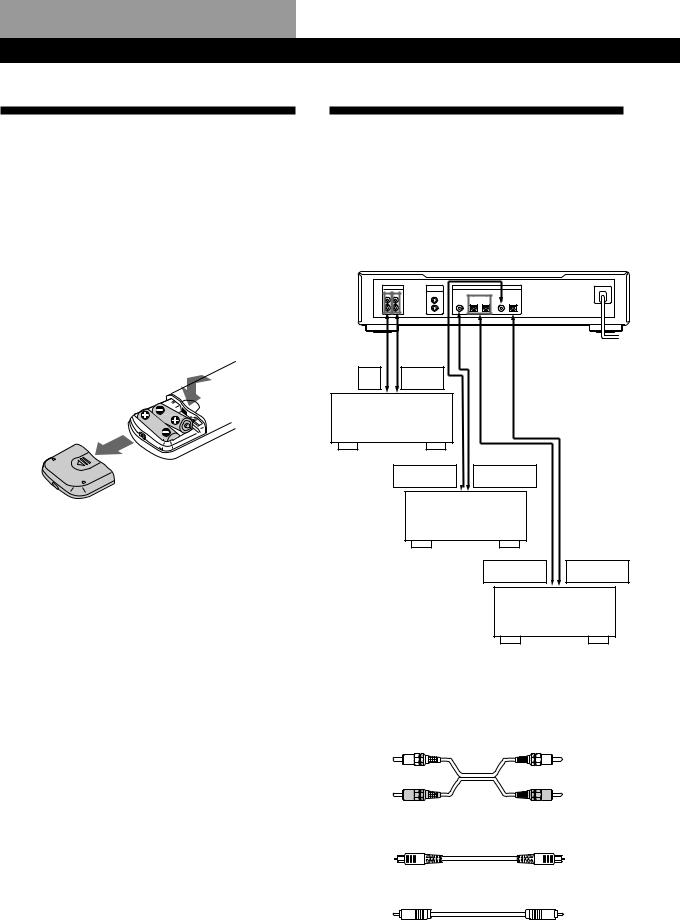
Getting Started
Unpacking
Check that you received the following items:
•Audio connecting cords (2)
•Optical cable (1)
•Remote commander (remote) RM-D17M (1)
•R6 (size-AA) batteries (2)
Inserting batteries into the remote
You can control the deck using the supplied remote. Insert two R6 (size-AA) batteries by matching the + and – on the batteries. When using the remote, point it at the remote sensor gon the deck.
zWhen to replace batteries
With normal use, the batteries should last for about six months. When the remote no longer operates the deck, replace all the batteries with new ones.
Notes
•Do not leave the remote near an extremely hot or humid place.
•Do not drop any foreign object into the remote casing, particularly when replacing the batteries.
•Do not expose the remote sensor to direct sunlight or lighting apparatuses. Doing so may cause a malfunction.
•If you don’t use the remote for an extended period of time, remove the batteries to avoid possible damage from battery leakage and corrosion.
Hooking Up the System
Overview
This section describes how to hook up the MD deck to an amplifier or other components such as a CD player or DAT deck. Be sure to turn off the power of each component before connection.
LINE |
|
S-LINK |
|
|
DIGITAL |
|
|
(ANALOG) |
CONTROL A1 |
COAXIAL |
OPTICAL |
COAXIAL OPTICAL |
|||
|
|||||||
IN OUT |
|
|
|
|
|
|
|
|
L |
|
IN |
IN2 |
IN1 |
OUT |
OUT |
|
R |
|
|
|
|
|
|
ç |
ç |
ç |
ç |
|
ç |
ç |
/ |
|
|
|
|
|
|
|
to a wall outlet |
REC |
TAPE/MD |
|
|
|
|
(or to a timer |
|
OUT |
|
IN |
|
|
|
|
during timer |
|
|
|
|
|
|
|
recording or |
Amplifier |
|
|
|
|
|
playback) |
|
|
|
|
|
|
|
||
DIGITAL DIGITAL
COAXIAL IN |
COAXIAL OUT |
CD player or
DAT deck, etc.
DIGITAL DIGITAL
OPTICAL OUT |
OPTICAL IN |
CD player, DAT deck, or MD deck, etc.
ç: Signal flow
What cords will I need?
• Audio connecting cords (supplied) (2)
White |
White |
|
(L) |
(L) |
|
Red |
Red |
|
(R) |
||
(R) |
||
|
•Optical cables (only one supplied) (3)
•Coaxial digital connecting cables (not supplied) (2)
4EN

Getting Started
Hookups
Connecting the deck to an amplifier
Connect the amplifier to the LINE (ANALOG) IN/ OUT jacks using the audio connecting cords (supplied), making sure to match the color-coded cords to the appropriate jacks on the components: red (right) to red and white (left) to white. Be sure to make connections firmly to prevent hum and noise.
MD deck |
ç |
Amplifier |
LINE |
TAPE / MD |
|
(ANALOG) |
|
OUT IN |
IN OUT |
|
|
|
|
|
L |
|
L |
R |
|
R |
Ç
ç: Signal flow
Connecting the deck to a digital component such as a CD player, DAT deck, digital amplifier, or another MD deck
Connect the component through the DIGITAL OPTICAL IN/OUT or DIGITAL COAXIAL IN/OUT connectors with two (or three) optical cables (only one supplied) and/or two coaxial digital connecting cables (not supplied).
When using the optical cables
Take the caps off the connectors and then insert the plugs parallelly until they click into place.
Be sure not to bend or tie together the optical cables.
|
|
MD deck |
|
Digital component |
||||
|
|
DIGITAL |
|
|
|
DIGITAL |
|
|
COAXIAL |
|
OPTICAL |
|
COAXIAL OPTICAL |
|
OPTICAL |
||
IN |
IN2 IN1 |
OUT |
OUT |
|
IN OUT |
|||
|
|
|
|
|
|
|
||
ç
Ç
You can connect the optical cable to either OPTICAL IN1 or IN2
ç: Signal flow
When using the coaxial digital connecting cable
|
MD deck |
|
Digital component |
|
|
DIGITAL |
|
|
DIGITAL |
COAXIAL |
OPTICAL |
COAXIAL OPTICAL |
COAXIAL |
|
|
|
|
|
|
IN |
IN2 IN1 |
OUT |
OUT |
IN OUT |
|
|
|
|
|
|
|
|
|
Ç |
Ç
ç: Signal flow
zIf “Din Unlock” and “C71” appear in the display
Make sure the optical cable or the coaxial digital connecting cable is connected properly.
zAutomatic conversion of digital sampling rates during recording
A built-in sampling rate converter automatically converts the sampling frequency of various digital sources to the 44.1 kHz sampling rate of your MD deck. This allows you to record sources such as 32and 48-kHz DAT or satellite broadcasts, as well as compact discs and other MDs.
Note
If “Din Unlock” alternates with “C71”, or “Cannot Copy” appears in the display, recording through the digital connector is not possible. In this case, record the program source through the LINE (ANALOG) IN jacks with the INPUT switch set at ANALOG.
Connecting the AC power cord
Connect the AC power cord to a wall outlet or to the outlet of a timer.
5EN
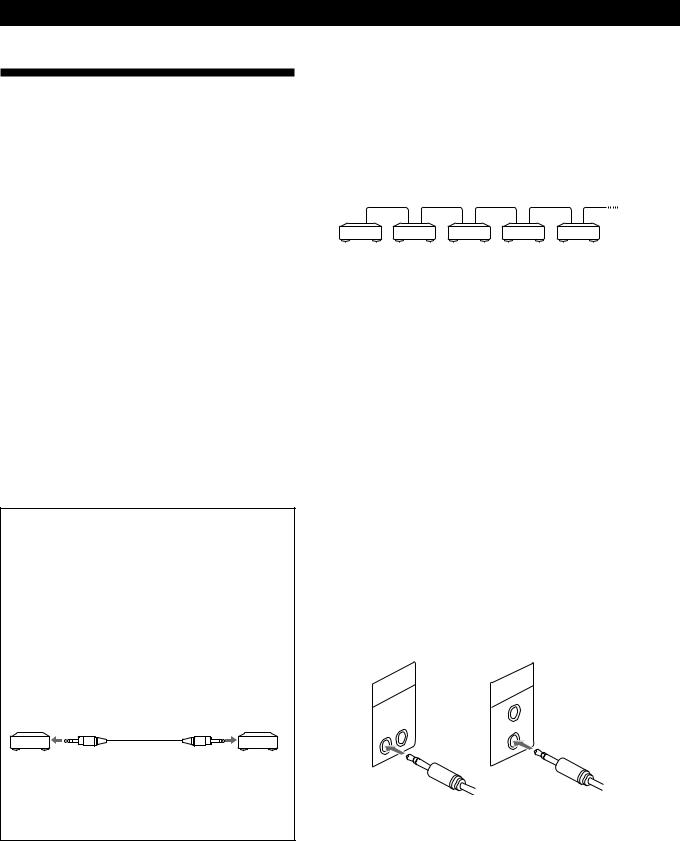
Getting Started
About the CONTROL A1 Control
System
This MD deck is compatible with the CONTROL A1 Control System.
The CONTROL A1 Control System was designed to simplify the operation of audio systems composed of separate Sony components. CONTROL A1 connections provide a path for the transmission of control signals which enable automatic operation and control features usually associated with integrated systems.
Currently, CONTROL A1 connections between a Sony MD deck, CD player, amplifier (receiver), and cassette deck provide automatic function selection and synchronized recording.
In the future the CONTROL A1 connection will work as a multifunction bus allowing you to control various functions for each component.
Note
The CONTROL A1 Control System is designed to maintain upward compatibility as the Control System is upgraded to handle new functions. In this case, however, older components will not be compatible with the new functions.
Compatibility with the former CONTROL A System
Although the CDP-CX153 is equipped with a CONTROL A terminal, it can be connected to CONTROL A1 components using a special connecting cable*.
The CDP-CX151 however, cannot be connected to CONTROL A1.
*Use the Sony RK-G139HG (1 meter [39 3/8 in]) monaural mini-plug ˜stereo mini-plug connecting cable or a similar cable (less than 2 meters [78 3/4 in] long with no resistance).
To CDP-CX153 |
To the CONTROL |
(CONTROL A) |
A1 component |
STEREO |
MONO |
Be sure to connect the STEREO mini-plug to the CONTROL A component and the MONO mini-plug to the CONTROL A1 component.
Connecting the CONTROL A1 Control
System
∙Connect the CONTROL A1 cables in series to the CONTROL A1 jacks on the back of each component. Be sure to connect a CONTROL A1 compatible amplifier (receiver) to take advantage of the automatic function selection feature.
Amplifier |
MD |
CD |
Tape |
Other |
(receiver) |
deck |
player |
deck |
component |
∙The components can be connected in any order.
∙You can connect up to ten CONTROL A1 compatible components.
∙The CONTROL A1 functions will work when the component you want to operate is turned on, even if all of the connected components are not turned on.
∙As a rule, the CONTROL A1 remote control system should not incorporate more than one of each type of component (i.e., 1 MD deck, 1 CD player, 1 tape deck and 1 receiver). You may, however, be able to connect more than one of certain CD players. Refer to the operating instructions supplied with the respective component for details.
About the CONTROL A1 cable
•Use a commercially available 2P (mono) mini-plug cable less than 2 meters (78 3/4 in) long, with a maximum outer diameter no greater than 11 mm (7/16 in), and no resistance. Some CONTROL A1 compatible components are supplied with a CONTROL A1 cable as an accessory.
•If a component has more than one CONTROL A1 jack, you can use either one, or connect a different component to each jack.
|
LINK |
A1 |
-LINK A1 |
- |
|
||
S |
|
|
S |
CONTROL |
|
CONTROL |
|
“S-LINK” is a general name for Sony’s Bus System, and includes the CONTROL A1 Control System.
6EN
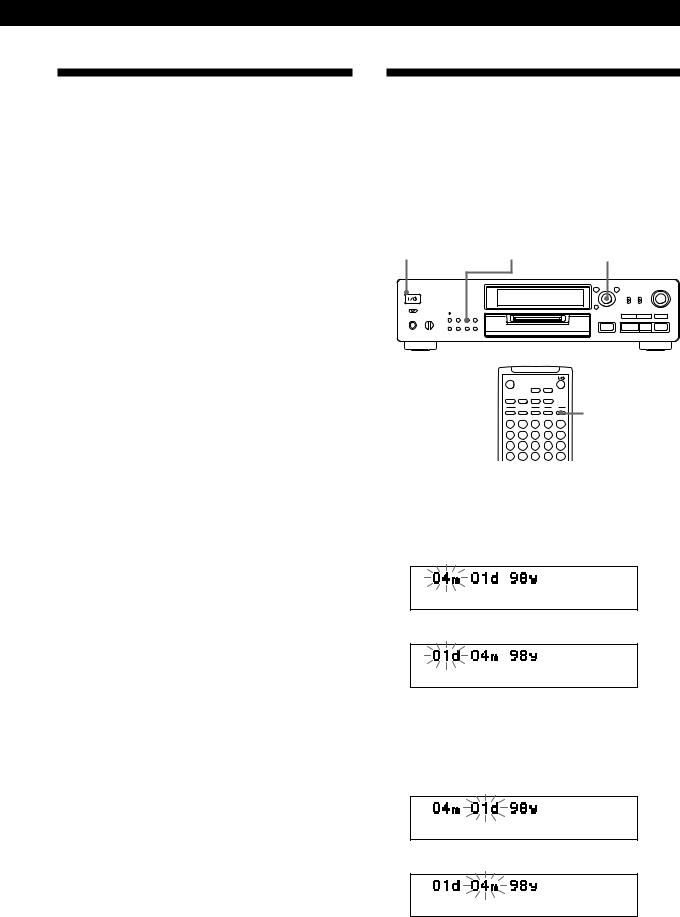
Getting Started
Basic Functions of the
CONTROL A1 Control System
Automatic function selection
When you connect CONTROL A1 compatible Sony components using CONTROL A1 cables, the function selector on the amplifier (or receiver) automatically switches to the correct input when you press the play button on one of the connected components.
(If you press ·(play button) on the MD deck while the CD is playing, the function selector on the amplifier switches from CD to MD.)
Notes
•This function only works when the components are connected to the amplifier (or receiver) inputs according to the names on the function buttons. Certain receivers allow you to switch the names of the function buttons. In this case, refer to the operating instructions supplied with the receiver.
•When recording, do not play any components other than the recording source. It will cause the automatic function selection to operate.
Synchronized recording
This function lets you conduct synchronized recording between the MD deck and selected source component.
1Set the source selector on the amplifier (or receiver) to the source component.
2Set the source component to pause mode (make sure both the ·and Pindicators light together).
3Set the deck to recording pause mode.
4Press Pon the deck.
The source component is released from the pause mode, and recording begins shortly thereafter. When playback ends from the source component, recording stops.
Notes
•Do not set more than one component to the pause mode.
•This MD deck is equipped with a special synchronized recording function that uses the CONTROL A1 Control System (see “Making a synchro recording from a CD player connected with a control A1 cable” on page 19). You can also make a synchro recording using the Mega CD Control Function via the CONTROL A1 Control System (see “Controlling a CD Changer from the MD Deck to Make a Synchro Recording” on page 37).
Setting the Clock
Once you set the MD deck’s internal clock, the MD deck will automatically record the date and time of all recordings. When playing a track, you can display the date and time the track was recorded (see page 24). Time on this deck is displayed on a 12-hour clock (USA and Canadian models only) or a 24-hour clock (European model only).
STANDBY SCROLL/CLOCK SET |
|
|
AMS ± |
|
||||||||
|
|
|
|
|
|
|
|
|
|
0 |
) |
r |
|
|
|
|
|
|
|
|
|
|
§ · |
P |
p |
|
EJECT |
|
|
|
|
|
|
|
|
|
|
|
|
6 |
|
|
MENU/NO |
YES |
|
|
|
|
|
||
DISPLAY |
SCROLL |
TIME |
|
D.O BIT |
|
|
|
|
|
|||
|
|
PLAY MODE |
|
|
DATE |
DATE |
|
|
||||
|
CONTINUE |
SHUFFLE PROGRAM RECORDED |
PRESENT |
|
|
|||||||
A |
|
B |
|
C |
|
D |
E |
|
|
|
||
F |
1 |
G |
2 |
H |
3 |
I |
4 |
J |
5 |
PRESENT |
|
|
K |
6 |
L |
7 |
M |
8 |
N |
9 |
O |
10 |
|
|
|
P 11 Q 12 R 13 S 14 T 15
U16 V 17 W 18 X 19 Y 20
1With the deck in standby status (the STANDBY indicator lights red), press SCROLL/CLOCK SET down for about 2 seconds until the month (or day) indication in the display starts flashing.
USA and Canadian models
European model
2Turn AMS to enter the current month (or day), then press AMS.
The month (or day) indication stops flashing, and the day (or month) indication starts flashing.
USA and Canadian models
European model
(Continued)
7EN

Getting Started
3Repeat Step 2 to enter the month, day, year, hour, and minute.
USA and Canadian models
European model
zFor precise time and date stamping of recordings
Reset the time at least once a week.
Note
If the AC power cord is disconnected for a long time, the memorized clock settings will disappear and “STANDBY” will flash in the display the next time you plug in and turn on the deck. If this happens, reset the clock.
Displaying the current date and time Z
You can display the current date and time any time even when the deck is in standby status.
Press DATE PRESENT.
Each press of the button changes the display as follows:
nCurrent display nDate nTime
zYou can display the current date and time with an on-deck button
Press the SCROLL/CLOCK SET button. Each press of the button changes the display in the same order as the DATE PRESENT button on the remote does.
Changing the date and/or time
1With the deck in standby status (the STANDBY indicator lights red), press SCROLL/CLOCK SET down for about 2 seconds until the month (or day) indication in the display starts flashing.
2Press SCROLL/CLOCK SET or AMS repeatedly until the item you want to change flashes.
3Turn AMS to change the contents of the selected item.
4To complete the setting, press AMS repeatedly until all items stop flashing.
Deactivating the demonstration mode
If the MD deck does not contain a disc, demonstration mode is activated automatically after about ten minutes.
To deactivate the demonstration mode, press any button on the MD deck or the remote.
8EN

|
|
|
|
|
|
|
|
|
Basic Operations |
|
Basic Operations |
|
Recording on an MD |
|
|
|
|
||
2 |
3 |
5 4 7 |
|
|
|
|
|
|
MENU/ |
AMS |
± YES |
|
|
REC LEVEL |
|
|
|
|
|
|
NO |
|
|
DIGITAL |
ANALOG |
||
|
|
|
|
|
|
|
|
|
|
4 |
5 |
|
|
|
|
|
|
|
|
|
|
6 |
|
STANDBY |
|
|
|
|
|
|
REC MODE |
INPUT |
– |
+ |
|
|
|
|
|
|
|
3 |
7 |
||||
|
|
|
|
|
|
|
|
|
|
||
|
|
|
|
|
|
|
STEREO |
OPT1 |
DIGITAL |
2 |
8 |
|
|
|
|
|
|
|
|
• |
• |
||
|
|
|
|
|
|
|
• |
OPT2• |
• |
|
|
|
|
|
|
|
|
|
• |
COAX• |
• |
|
|
|
|
|
|
|
CLEAR |
|
MONO |
|
•ANALOG |
1 |
9 |
TIMER |
|
|
|
|
|
|
|
|
|
0 |
10 |
|
|
|
|
|
|
PUSH ENTER |
|
|
|
|
|
REC OFF PLAY |
|
|
|
|
|
|
|
|
|
REC |
|
|
MEGA |
MUSIC |
SCROLL/ |
DISPLAY/ |
|
0 |
|
) |
|
r |
|
|
|
|
|
|
|||||||
|
|
CONTROL |
SYNC |
CLOCK SET |
CHAR |
|
|
|
|||
PHONES |
PHONE LEVEL |
|
|
|
EJECT |
|
|
|
|
||
|
|
|
|
|
|
|
|
|
|
||
|
|
FADER |
PLAY MODE |
REPEAT |
TIME |
§ |
· |
P |
|
p |
|
|
0 |
10 |
|
|
|
|
|||||
|
|
|
|
|
|
|
|
|
|
||
Monitor audio during recording
Even if you set REC MODE to MONO, the monitor signal does not become monaural.
|
8 |
6 |
||
|
|
|||
1 |
Turn on the amplifier and play the program source you want |
|||
to record. |
|
|||
|
|
|
||
2 |
Press 1/u. |
|
||
The STANDBY indicator turns off. |
|
|||
|
|
|
||
3 |
Insert a recordable MD. |
|
||
|
|
|
|
|
|
|
|
|
|
With the arrow pointing this way |
With the label side up |
If the MD has a recorded material on it, the deck will automatically start recording from the end of the last recorded track.
4 |
Set INPUT to the corresponding input connector. |
|
|
|
|
To record through |
Set INPUT to |
|
|
DIGITAL OPTICAL IN1 |
OPT1 |
|
|
|
|
DIGITAL OPTICAL IN2 |
OPT2 |
|
DIGITAL COAXIAL IN |
COAX |
|
|
|
|
LINE (ANALOG) IN |
ANALOG |
|
|
|
|
|
|
5 |
Set REC MODE to the mode you want to record in. |
||
|
|
||
To record in |
Set REC MODE*1 to |
||
|
Stereo sound |
STEREO |
|
|
Monaural sound*2 |
MONO |
|
|
*1 |
If you switch REC MODE during recording or recording pause, recording |
|
|
|
stops. |
|
|
*2 |
In the monaural recording, you can record about two times longer than in |
|
|
|
the stereo recording. |
|
(Continued)
9EN
Operations Basic
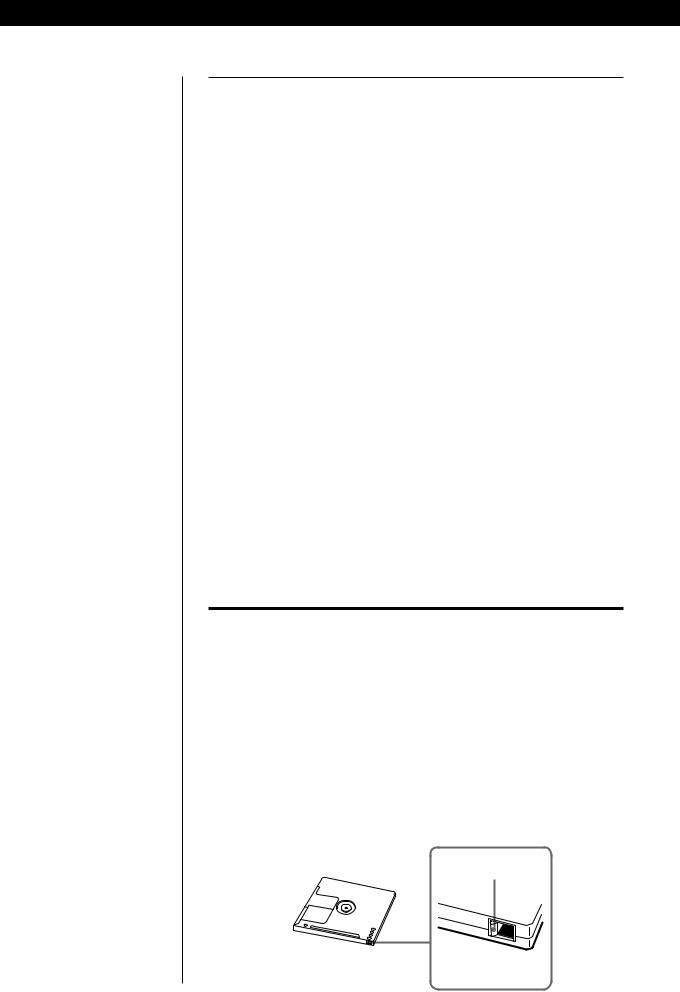
Basic Operations
When “TOC Writing” flashes in the display
The deck is currently updating the Table Of Contents (TOC). Do not move the deck or pull out the AC power cord. Changes to an MD made through recording are saved only when you update the TOC by ejecting the MD or changing the deck to standby by pressing the 1/uswitch.
10EN
6 |
Press rREC. |
The deck becomes ready to record. |
|
|
|
7 |
Adjust the recording level. |
|
When recording through the DIGITAL COAXIAL IN, OPTICAL IN1, or |
|
IN2 connector |
|
Adjust the outer REC LEVEL (DIGITAL) control so that the |
|
peak level meter in the display is a maximum of 0 dB. For |
|
details, see page 15. |
|
When recording through the LINE (ANALOG) IN jacks |
|
Setting the inner REC LEVEL (ANALOG) control at 4 is |
|
satisfactory for most purposes. For details, see page 15. |
|
|
8 |
Press · or P. |
Recording starts. |
|
|
|
9 |
Start playing the program source. |
|
|
Do not disconnect the deck from the power source immediately after recording
If you do, recorded material may not be saved to the MD. To save the material, after recording, press §EJECT to take out the MD or change the deck to standby by pressing 1 /u . “TOC Writing” will flash in the display at this time.
After “TOC Writing” stops flashing and goes out, you can pull out the AC power cord.
To |
Press |
|
|
Stop recording |
p |
|
|
Pause recording* |
P. Press the button again or press ·to resume |
|
recording. |
|
|
Take out the MD |
§EJECT after stopping |
|
|
*Whenever you pause recording, the track number increases by one. For example, if you paused recording while recording on track 4, the track number increases by one and recording continues on the new track when restarted.
To protect an MD against accidental erasure
To make it impossible to record on an MD, slide the tab in the direction of arrow, opening the slot. To allow recording, close the slot.
Record-protect tab
Rear of the disc  Slide the tab in the
Slide the tab in the
direction of arrow
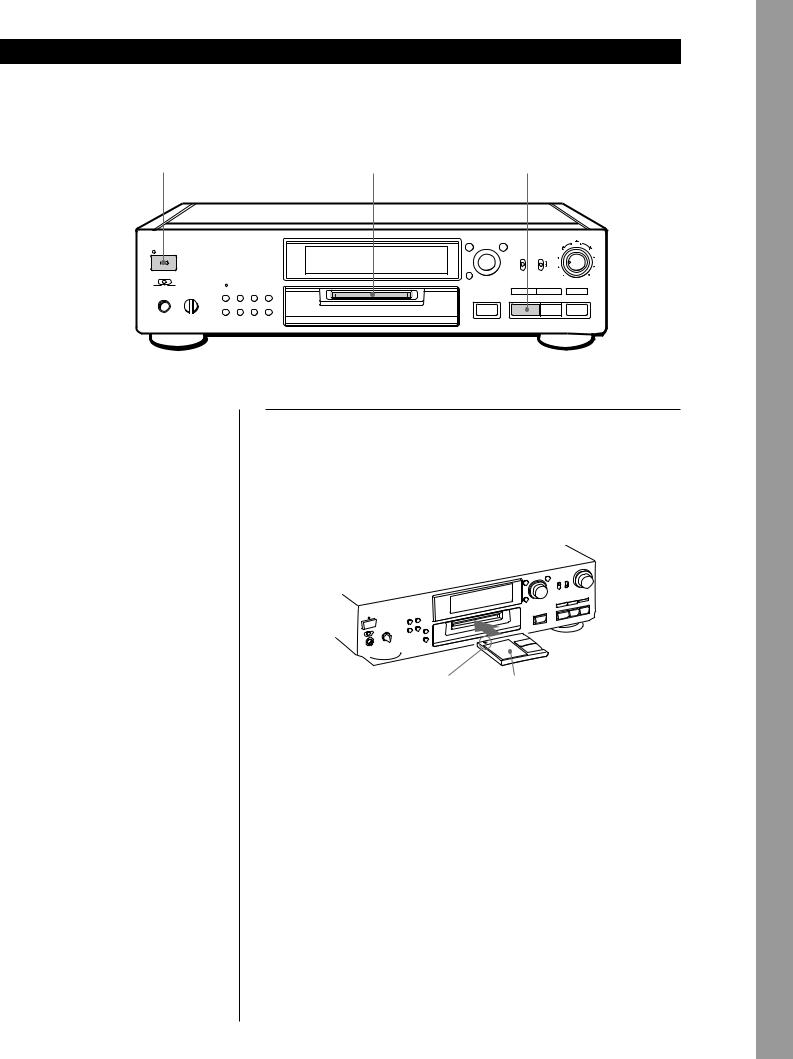
Basic Operations
Playing an MD
2 |
3 |
4 |
|
|
|
|
|
MENU/ |
AMS |
± YES |
|
|
REC LEVEL |
|
|
|
|
|
|
NO |
|
|
DIGITAL |
ANALOG |
||
|
|
|
|
|
|
|
|
|
|
4 |
5 |
|
|
|
|
|
|
|
|
|
|
6 |
|
STANDBY |
|
|
|
|
|
|
REC MODE |
INPUT |
– |
+ |
|
|
|
|
|
|
|
3 |
7 |
||||
|
|
|
|
|
|
|
|
|
|
||
|
|
|
|
|
|
|
STEREO |
OPT1 |
DIGITAL |
2 |
8 |
|
|
|
|
|
|
|
|
• |
• |
||
|
|
|
|
|
|
|
• |
OPT2• |
• |
|
|
|
|
|
|
|
|
|
• |
COAX• |
• |
|
|
|
|
|
|
|
CLEAR |
|
MONO |
|
•ANALOG |
1 |
9 |
|
|
|
|
|
|
|
|
|
|
||
TIMER |
|
|
|
|
|
|
|
|
|
0 |
10 |
|
|
|
|
|
|
PUSH ENTER |
|
|
|
|
|
REC OFF PLAY |
|
|
|
|
|
|
|
|
|
REC |
|
|
MEGA |
MUSIC |
SCROLL/ |
DISPLAY/ |
|
0 |
|
) |
|
r |
|
|
|
|
|
|
|||||||
|
|
CONTROL |
SYNC |
CLOCK SET |
CHAR |
|
|
|
|||
PHONES |
PHONE LEVEL |
|
|
|
EJECT |
|
|
|
|
||
|
|
|
|
|
|
|
|
|
|
||
|
|
FADER |
PLAY MODE |
REPEAT |
TIME |
§ |
· |
P |
|
p |
|
|
0 |
10 |
|
|
|
|
|||||
|
|
|
|
|
|
|
|
|
|
||
zYou can locate and play back a track while the deck is stopped
1Turn AMS (or press = or +) until the number of the track you want to play appears.
2Press AMS or ·.
zTo use headphones
Connect them to PHONES jack. Use PHONE LEVEL to adjust the volume.
zYou can change the MD playback speed
See “Changing the Pitch” on page 32.
1 |
Turn on the amplifier and set the source selector to the position |
||
for MD deck. |
|||
2 |
Press 1/u. |
||
The STANDBY indicator turns off. |
|||
|
|
||
3 |
Insert an MD. |
||
|
|
|
|
|
|
|
|
|
With the arrow pointing this way |
With the label side up |
|
|
|
|
|
4 |
Press ·. |
|
|
The deck starts playing. Adjust the volume on the amplifier. |
|||
|
|
|
|
|
|
|
|
To |
|
Do the following: |
|
|
|
|
|
Stop playing |
Press p. |
|
|
|
|
||
Pause playing |
Press P. Press the button again or press ·to |
||
|
|
resume playing. |
|
|
|
||
Go to the next track |
Turn AMS clockwise (or press + on the |
||
|
|
remote). |
|
|
|
||
Go to the current track |
Turn AMS counterclockwise (or press =on the |
||
or the preceding track |
remote). |
|
|
|
|
||
Take out the MD |
Press §EJECT after stopping playing. |
||
|
|
|
|
Operations Basic
11EN

Recording on MDs
Notes on Recording
If “Protected” alternates with “C11” in the display
The MD is record-protected. Close the slot to record on the disc (see “To protect an MD against accidental erasure” on page 10).
If “Din Unlock” alternates with “C71” in the display
•The digital program source is not connected as you set with the INPUT switch in Step 4 on page 9.
To continue, connect the program source properly.
•The program source is not on. Turn on the program source.
Depending on the menu settings and source being recorded, track numbers are marked in following ways:
•When recording from a CD or MD with the INPUT switch set at a digital position (OPT1, OPT2 or COAX) and the source connected through the digital input (DIGITAL OPTICAL IN1, IN2 or DIGITAL COAXIAL IN) connector:
The deck automatically marks track numbers in the same sequence as the original. If, however, a track is repeated two or more times (e.g. by single-track repeat play) or two or more tracks with the same track number (e.g. from different MDs or CDs) are played, the track or tracks are recorded as part of a single, continuous track with a single track number. If the source is an MD, track numbers may not be marked for tracks of less than 4 seconds.
•When recording from some CD players and multi disc players connected through one of the digital input connectors with the INPUT switch set at the respective digital position:
The deck may not automatically mark track numbers. In these cases, mark the track numbers after recording, using the deck’s Divide Function (see “Dividing Recorded Tracks” on page 42).
•When recording from a source connected through the LINE (ANALOG) IN jacks with the INPUT switch set at ANALOG or when recording from a DAT or satellite broadcast connected through one of the digital input connectors with the INPUT switch set at the respective digital position and “T.Mark Off” selected in Setup Menu 02:
The source will be recorded as a single track.
•Even while recording an analog source or a DAT or satellite broadcast, you can mark track numbers if “T.Mark LSyn” is selected in Setup Menu 02 (see “Marking Track Numbers While Recording” on page 16).
•When recording from DAT or satellite broadcasts with the INPUT switch set at the respective digital position, the deck automatically marks a track number whenever the sampling frequency of the input signal changes regardless of the Setup Menu 02 setting.
zYou can mark track numbers during or after recording
For details, see “Marking Track Numbers While Recording” (page 16) and “Dividing Recorded Tracks” (page 42).
When “TOC Writing” flashes in the display
The deck is currently updating the Table Of Contents (TOC). Do not move the deck or pull out the AC power cord. Changes to an MD made through recording are saved only when you update the TOC by ejecting the MD or changing the deck to standby by pressing the 1/uswitch.
The MD deck uses the SCMS (Serial Copy Management System on page 53)
MDs recorded through digital input connector cannot be copied onto other MDs or DAT tapes through the digital output connector.
When the deck is recording or in recording pause, digital signals input through one of the digital input connectors are output to the respective digital output connector with the same sampling rate
To change the digital input signal to another sampling rate for output (without recording it to an MD), use Input Monitor Function (see page 13).
12EN
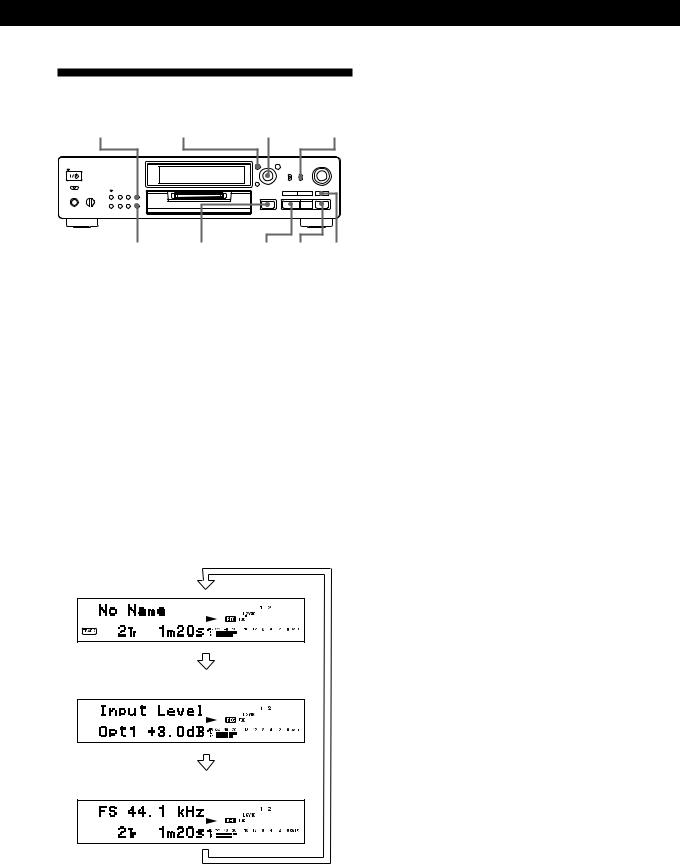
Recording on MDs
Useful Tips for Recording
DISPLAY/CHAR |
MENU/NO |
AMS ± INPUT |
||
|
|
0 |
) |
r |
|
|
§ · |
P |
p |
TIME |
§EJECT |
· |
p |
rREC |
Checking the remaining recordable time on the MD
Press TIME.
•When you press the TIME button repeatedly while the deck is stopped, the display alternates between total disc playing time and remaining recordable time on the MD (see page 23).
•When you press the TIME button repeatedly while recording, the display alternates between the recording time of the current track and the remaining recordable time on the MD.
Changing the display while recording
Each time you press DISPLAY/CHAR (or DISPLAY) while the deck is recording, you can change the display as follows:
Normal display
Press
Recording level display
Press
FS (sampling frequency) display
Press
Monitoring the input signal (Input Monitor)
Before starting recording, you can monitor the selected input signal through the deck’s output connectors.
1Press § EJECT to remove the MD.
2Set INPUT according to the input signal you want to monitor.
When the INPUT switch is set at ANALOG
The analog signal input through the LINE (ANALOG) IN jacks is output to the digital output connector after A/D conversion, and then to the LINE (ANALOG) OUT jacks and the PHONES jack after D/A conversion.
When the INPUT switch is set at OPT1, OPT2 or COAX
After passing through the sampling rate converter, the digital signal input through the respective digital input connector is output to the digital output connector, and after D/A conversion to the LINE (ANALOG) OUT jacks and PHONES jack.
3Press rREC.
If the INPUT switch is set at ANALOG, “AD-DA” appears in the display.
If the INPUT switch is set at OPT1, OPT2 or COAX, “-DA” appears in the display.
If “Auto Cut” appears in the display (Auto Cut)
There has been no sound input for about 30 seconds during recording. The 30 seconds of silence are replaced by a blank of about 3 seconds and the deck changes to recording pause.
If the deck continues pausing for about 10 minutes after the Auto Cut Function activated, recording stops automatically.
Note that this function does not activate even if there has been no sound input for about 30 seconds when the deck started recording from the blank portion.
zYou can turn off the Auto Cut Function
For details, see “To turn off the Smart Space Function and Auto Cut Function” on page 14. Note that when you turn off the Auto Cut Function, the Smart Space Function is turned off automatically.
(Continued)
13EN

Recording on MDs
If “Smart Space” appears in the display (Smart Space)
There has been an extended silence of 4 to 30 seconds in length during recording. The silence is replaced with a blank of about 3 seconds and the deck continues recording. Note that new track numbers may not be marked for portions recorded while this function is activated. Also, the Smart Space Function does not activate even if there has been an extended silence of 4 to 30 seconds in length when the deck started recording from the blank portion.
To turn off the Smart Space Function and Auto Cut Function
1 While the deck is stopped, press MENU/NO twice to display “Setup Menu”.
2 Turn AMS to select “Setup 05”, then press AMS.
3 Turn AMS to select “S.Space Off”, then press AMS. 4 Press MENU/NO.
To turn on the Smart Space Function and Auto Cut Function again
1 Do Steps 1 and 2 in “To turn off the Smart Space Function and Auto Cut Function” above.
2 Turn AMS to select “S.Space On”, then press AMS. 3 Press MENU/NO.
Notes
•When you turn off the Smart Space Function, the Auto Cut Function is also turned off automatically.
•The Smart Space Function and Auto Cut Function are factory set to on.
•If you turn off the deck or disconnect the AC power cord, the deck will recall the last setting (On or Off) of the Smart Space and Auto Cut Functions the next time you turn on the deck.
Switching the bit length
You can improve the recording quality by switching the bit length to match the CD player or DA converter connected to the digital input connector.
1While the deck is stopped, press MENU/NO twice to display “Setup Menu”.
2Turn AMS to select “Setup 12”, then press AMS.
3Turn AMS to select the desired bit length, then press AMS.
4Press MENU/NO.
Notes
•This function operates only for the digital signal input through the digital input connector.
•The bit length is normally set to 20 bits, but you can select from 24, 20 or 16 bits.
•If you switch the bit length during recording, the sound drops out momentarily.
Playing back tracks just recorded
Do this procedure to immediately play back tracks that have just been recorded.
Press ·immediately after stopping recording. Playback starts from the first track of the material just recorded.
To play from the first track of the MD after recording
1Press pagain after stopping recording.
2Press ·.
Playback starts from the first track of the MD.
Recording Over Existing Tracks
Follow the procedure below to record over existing material just as you would on an analog cassette tape.
1Do Steps 1 to 5 in “Recording on an MD” on page 9.
2Turn AMS (or press =or +) until the number of the track to be recorded over appears.
3To record from the start of the track, continue from Step 6 in “Recording on an MD” on page 10.
zWhile “Tr” flashes in the display
The deck is recording over an existing track, and stops flashing when it reaches the end of the recorded portion.
zTo record from the middle of the track
1 After Step 2 above, press ·to start playback. 2 Press P where you want to start recording.
3 Continue from Step 6 in “Recording on an MD” on page 10.
Note
You cannot record from the middle of an existing track when the “PROGRAM” or “SHUFFLE” is on.
14EN

Recording on MDs
Adjusting the Recording Level
You can adjust the recording level before starting recording.
REC LEVEL
MENU/NO (DIGITAL/ANALOG)
0 ) r
§ |
· P p |
AMS ±
U 16 V 17 W 18 X 19 Y 20
Z 21 – 22  23 . 24 , 25
23 . 24 , 25
REPEAT A˜B A.SPACE M.SCAN
/ >25 ? !
! (
( )
)
WRITE |
|
CLEAR P.HOLD |
P. HOLD |
NAME CHAR |
NUM |
|
|
· P p
REC-IT
=+ r
T.REC MUSIC SYNC
0)
CD-SYNC
STOP START STANDBY
CD PLAYER FADER |
DIGITAL REC LEVEL |
P = + |
|
/ANALOG OUT LEVEL /ANALOG OUT LEVEL +/– |
|
DIGITAL REC LEVEL |
|
Adjusting the digital recording level
You do not normally need to adjust the digital recording level. The level is adjusted mainly when the level of the source is low.
1Do Steps 1 to 6 in “Recording on an MD” on pages 9 and 10.
2Play the portion of the program source with the strongest signal level.
3While monitoring the sound, turn outer REC LEVEL (DIGITAL) (or press DIGITAL REC LEVEL/ANALOG OUT LEVEL +/–) to adjust the recording level so that the peak level meters reach their highest point without turning on the OVER indication. Occasional lighting of “OVER” is acceptable.
OVER indication
If the digital signal level of the source is too low, it may not be possible to set the recording level to maximum.
4Stop playing the program source.
5To start recording, do the procedure starting from Step 8 in “Recording on an MD” on page 10.
zThe Peak Hold Function freezes the level meter display at the highest level reached by the input signal
To turn on the Peak Hold Function by Setup Menu 06 setting
1While the deck is stopped, press MENU/NO twice to display “Setup Menu”.
2Turn AMS to select “Setup 06”, then press AMS.
3Turn AMS to select “P.Hold On”, then press AMS.
4Press MENU/NO.
To turn on the Peak Hold Function using the remote
Press P.HOLD to display “P.Hold On.”
To turn off the Peak Hold Function, select “P.Hold Off” in Step 3 above. (Or press P.HOLD on the remote to display “P.Hold Off”.)
Adjusting the analog recording level
1Do Steps 1 to 6 in “Recording on an MD” on pages 9 and 10.
2Play the portion of the program source with the strongest signal level.
3While monitoring the sound, turn inner REC LEVEL (ANALOG) to adjust the recording level. If the output level of the connected component is too low, it may not be possible to set the recording level to maximum.
4Stop playing the program source.
5To start recording, do the procedure starting from Step 8 in “Recording on an MD” on page 10.
15EN

Recording on MDs
Marking Track Numbers While
Recording (Track Marking)
You can mark track numbers either manually or automatically. By marking track numbers at specific points, you can quickly locate the points later using the AMS Function, or use various Editing Functions.
MENU/NO |
|
rREC |
0 |
) |
r |
§ · |
P |
p |
AMS ±
Marking track numbers manually (Manual Track Marking)
You can mark track numbers at any time while recording on an MD.
Press rREC at the place you want to add a track mark while recording.
Marking track numbers automatically (Automatic Track Marking)
The deck adds track marks differently in the following cases:
•When recording from CDs or MDs with the INPUT switch set at OPT1, OPT2 or COAX:
The deck marks track numbers automatically. However, the Automatic Track Marking Function may not activate when recording from some CD players and multi disc players.
•In all other cases:
If “T.Mark LSyn” is selected in Setup Menu 02, the deck marks a new track number whenever the signal drops to the specified level or below for about
1.5 seconds or longer, then rises to a specified level.
To select “T.Mark Off” or “T.Mark LSyn” in Setup Menu 02, do the procedure below:
1While the deck is stopped, press MENU/NO twice to display “Setup Menu”.
2Turn AMS to select “Setup 02”, then press AMS.
3Turn AMS to select “T.Mark Off” or “T.Mark LSyn”, then press AMS.
“L.SYNC” lights up when you select “T.Mark LSyn”.
4Press MENU/NO.
zYou can set the reference level that must pass before a rise marks a new track number
In Automatic Track Marking, the input signal must remain at or below a given reference level for
1.5 seconds or longer before a rise above the reference level will mark a new track number.
Do the following procedure to specify the reference level. Note that “T.Mark LSyn” should be selected in Setup Menu 02.
1 While the deck is stopped, press MENU/NO twice to display “Setup Menu”.
2 Turn AMS to select “Setup 03”, then press AMS. 3 Turn AMS to set the reference level.
You can set the reference level at –72 dB to 0 dB in 2 dB steps.
4 After selecting the reference level, press AMS.
5 Press MENU/NO.
Note
If you turn off the deck or disconnect the AC power cord, the deck will recall the last settings of the Automatic Track Marking Function (“T.Mark LSyn” or “T.Mark Off”) the next time you turn on the deck.
16EN
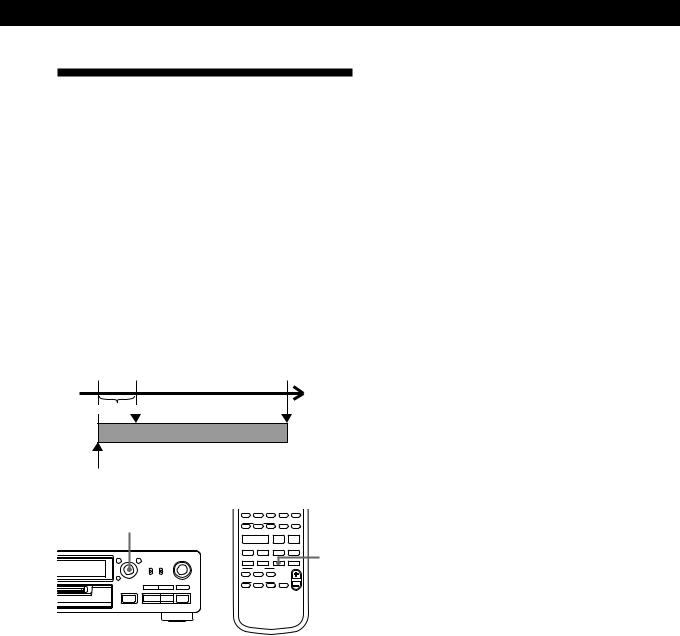
Recording on MDs
Starting Recording With
6 Seconds of Prestored Audio
Data (Time Machine Recording)
When recording from an FM or satellite broadcast, the first few seconds of material are often lost due to the time it takes you to ascertain the contents and press the record button. To prevent the loss of this material, the Time Machine Recording Function constantly stores
6 seconds of the most recent audio data in a buffer memory so that when you begin recording the program source using this function, the recording actually begins with the 6 seconds of audio data stored in the buffer memory in advance as shown in the illustration below.
When you press |
End of the program |
AMS in Step 3 |
source to be recorded |
Time |
Audio data in 6-second buffer memory |
Recorded |
portion |
Beginning of the program source to be recorded
/ >25 ? |
REPEAT |
A˜B |
A.SPACE M.SCAN |
! |
( |
) |
AMS ± |
|
|
WRITE |
CLEAR P.HOLD |
|
|||
|
|
|
|
NAME |
CHAR |
NUM |
|
|
|
|
|
|
|
· |
P |
p |
|
|
|
|
|
|
|
|
REC-IT |
|
|
|
|
|
= |
+ |
r |
|
T.REC |
|
|
|
|
|
|
T.REC |
MUSIC SYNC |
|
|
|
|
|
0 |
) |
|
|
|
|
|
|
|
|
CD-SYNC |
|
|
|
|
|
|
|
STOP |
START STANDBY |
|
|
|
|
|
|
|
|
CD PLAYER |
FADER |
|
|
|
0 |
) |
r |
P |
= + |
|
|
|
|
|
|
|
|
|
|
DIGITAL REC LEVEL |
|
§ |
· |
|
|
|
|
|
/ANALOG OUT LEVEL |
|
P |
p |
|
|
|
|
|
||
1Do Steps 1 to 6 in “Recording on an MD” on pages 9 and 10.
The deck changes to recording pause.
2Start playing the program source you want to record.
The most recent 6 seconds of audio data is stored in the buffer memory.
3Press AMS (or T.REC) to start Time Machine Recording.
Recording of the program source starts with the 6 seconds of audio data stored in the buffer memory.
To stop Time Machine Recording
Press p.
Note
The deck starts storing audio data when the deck is in recording pause and you start playing the program source. With less than 6 seconds of playing of the program source and audio data stored in the buffer memory, Time Machine Recording starts with less than 6 seconds of audio data.
17EN
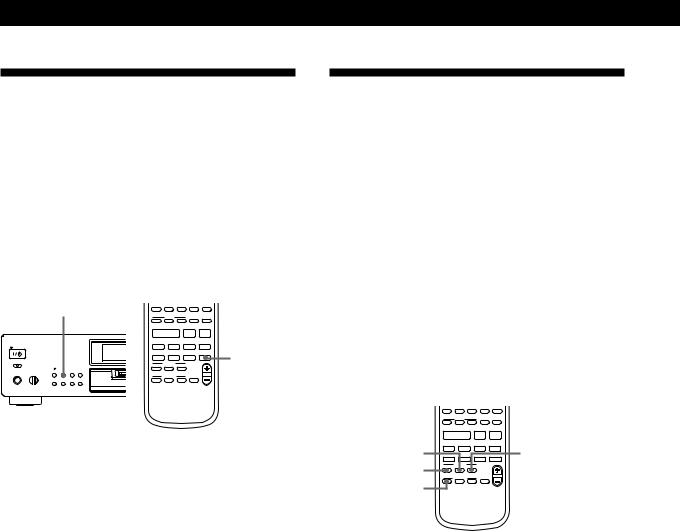
Recording on MDs
Synchro-Recording With Audio
Equipment of Your Choice
(Music Synchro-Recording)
By using the MUSIC SYNC button, you can automatically start recording in sync with the signal input from the program source.
The method of marking track numbers differs, depending on the program source being recorded and the setting of the Setup Menu 02 (see “Notes on Recording” on page 12).
MUSIC SYNC |
/ >25 ? |
REPEAT |
A˜B |
A.SPACE |
M.SCAN |
|
! |
( |
) |
|
|
|
|
WRITE |
|
CLEAR |
P.HOLD |
|
NAME |
CHAR |
NUM |
|
|
|
· |
P p |
|
|
|
REC-IT |
|
= |
+ |
r |
|
|
CD-SYNC |
T.REC MUSIC SYNC |
MUSIC SYNC |
0 |
) |
|
|
STOP |
START STANDBY |
|
|
|
CD PLAYER |
FADER |
|
P |
= + |
|
|
DIGITAL REC LEVEL /ANALOG OUT LEVEL
1Do Steps 1 to 5 in “Recording on an MD” on page 9.
2Press MUSIC SYNC.
The deck changes to recording pause.
3Start playing the program source you want to record.
The deck starts recording automatically.
To stop Music Synchro-Recording
Press p.
Note
When Music Synchro-Recording, the Smart Space Function and the Auto Cut Function turn on automatically regardless of their setting (On or Off) and type of input (digital or analog).
Synchro-Recording With a Sony
CD Player Z
By connecting your deck to a Sony CD player or Hi-Fi Component System, you can easily dub CDs onto MDs using the CD synchro buttons on the remote. If your deck is connected to a Sony CD player by a digital input cable, track numbers are automatically marked as appear on the original even when “T.Mark Off” is selected in Setup Menu 02. If your deck is connected to a Sony CD player by audio connecting cords through the LINE (ANALOG) IN jacks, track numbers are automatically marked when you set Setup Menu 02 to “T.Mark LSyn” (see page 16).
As the same remote controls both the CD player and the deck, you may have trouble operating both units if they are far from each other. If you do, place the CD player close to this deck.
|
/ >25 |
REPEAT |
|
A˜B A.SPACE M.SCAN |
|
|
|
? |
! |
( |
) |
|
|
|
|
WRITE |
|
CLEAR |
P.HOLD |
|
|
NAME |
CHAR |
|
NUM |
|
|
|
|
· |
|
P |
p |
|
|
|
|
|
|
REC-IT |
|
START |
= |
+ |
r |
|
STANDBY |
|
0 |
) |
T.REC MUSIC SYNC |
||||
STOP |
|
CD-SYNC |
|
|
|
|
STOP |
START |
STANDBY |
|
|
||
|
CD PLAYER |
FADER |
|
|
||
CD PLAYER P |
P |
= + |
|
|
||
|
|
|
DIGITAL REC LEVEL |
|
||
|
|
|
|
/ANALOG OUT LEVEL |
|
|
1Set the source selector on the amplifier to CD.
2Do Steps 2 to 5 in “Recording on an MD” on page 9 to prepare the deck for recording.
3Insert a CD into the CD player.
4Select the playback mode (Shuffle Play, Program Play, etc.) on the CD player.
5Press STANDBY.
The CD player pauses for playing and the deck pauses for recording.
18EN

Recording on MDs
6Press START.
The deck starts recording and the CD player starts playback.
The track number and elapsed recording time of the track appear in the display.
If the CD player does not start playing
Some CD player models may not respond when
you press START on the remote of the deck. Press Pon the remote of the CD player instead.
7Press STOP to stop synchro-recording.
To pause recording
Press STANDBY or CD PLAYER P.
To restart recording, press START or CD PLAYER P. A new track number is marked each time you pause recording.
Notes
•When the deck’s remote controls the CD player with a mode selector, set the selector to CD1.
•The deck may not automatically mark track numbers when recording from some CD players.
zYou can use the remote of the CD player during synchro-recording
When you press p, the CD player stops and the deck pauses for recording.
When you press P, the CD player pauses and the deck pauses for recording.
To restart synchro-recording, press ·.
zYou can change CDs during synchro-recording
Do the following steps instead of Step 7 above.
1Press pon the remote of the CD player. The deck pauses for recording.
2Change the CD.
3Press ·on the remote of the CD player. Synchro-recording restarts.
zYou can also do synchro-recording with a Sony video CD player
Using the procedure for synchro-recording with a Sony CD player, you can do synchro-recording with a Sony video CD player also.
To select the video CD player, press button number 2 while pressing down the 1/u switch on the remote before starting the procedure.
To select the CD player again, press button number 1 while pressing down the 1/u switch.
The deck is factory set to a CD player for synchrorecording.
zYou can check the remaining recordable time on the MD
Press TIME (see page 23).
zDuring synchro-recording, the deck copies CD text information (CD text and disc memos) as it is to the MD (Disc Memo Copy Function)
The Disc Memo Copy function operates when you make a synchro-recording from a Sony CD player connected with a control A1 cable to the MD deck.
Making a synchro recording from a CD player connected with a control A1 cable
You can make a synchro recording from a Sony CD player with a CONTROL A1 jack connected with a control A1 cable to the MD deck.
1Turn on the amplifier and set the source selector to CD.
2Do Steps 2 to 5 of “Recording on an MD” on page 9.
3Set the CD player to the play mode (e.g., Program Play or Shuffle Play) you want to use to record to the MD deck.
4Set the CD player to playback pause mode. (· and Pboth light up.)
5Press rREC on the deck.
The MD deck stands by for recording.
6Press P on the deck.
CD player pause is canceled and recording starts. When CD play finishes, recording stops.
Notes
•The Disc Memo Copy Function may not operate for extremely short CD tracks.
•Text information may not be copied for some CDs.
19EN
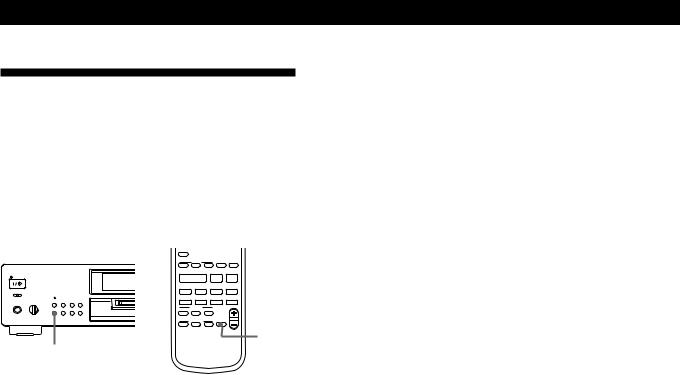
Recording on MDs
Fading In and Out (Fader)
You can gradually increase the recording level at the beginning of a recording (fade-in recording) or gradually decrease the recording level at the end of a recording (fade-out recording).
This function is convenient when, for example, you don’t want the track cut off abruptly when the disc reaches to its end.
REPEAT A˜B A.SPACE M.SCAN
/ >25 ? !
! (
( )
)
|
WRITE |
CLEAR P.HOLD |
NAME |
CHAR |
NUM |
|
· |
P |
p |
|
|
|
REC-IT |
= |
+ |
r |
|
|
|
T.REC |
MUSIC SYNC |
0 |
) |
|
|
|
CD-SYNC |
|
|
STOP |
START STANDBY |
|
|
|
CD PLAYER |
FADER |
|
P = +
DIGITAL REC LEVEL |
FADER |
/ANALOG OUT LEVEL |
FADER
Fade-in recording
During recording pause, press FADER at the position where you want to start fade-in recording.
Zin “Fade Z3.2s” flashes and the deck performs the fade-in recording until the counter reaches “0.0s”.
Fade-out recording
During recording, press FADER at the position where you want to start fade-out recording.
zin “Fade z3.2s” flashes and the deck performs the fade-out recording until the counter reaches “0.0s”. The deck changes to recording pause when fade-out recording finishes.
zYou can set the duration of fade-in and fade-out recording independently
1While the deck is stopped, press MENU/NO twice to display “Setup Menu”.
2To set the duration of fade-in recording:
Turn AMS to select “Setup 08”, then press AMS.
To set the duration of fade-out recording:
Turn AMS to select “Setup 09”, then press AMS.
3Turn AMS to set the duration.
Both the fade-in and fade-out recording durations can be set in 0.1 second steps.
4After selecting the duration, press AMS.
5Press MENU/NO.
20EN
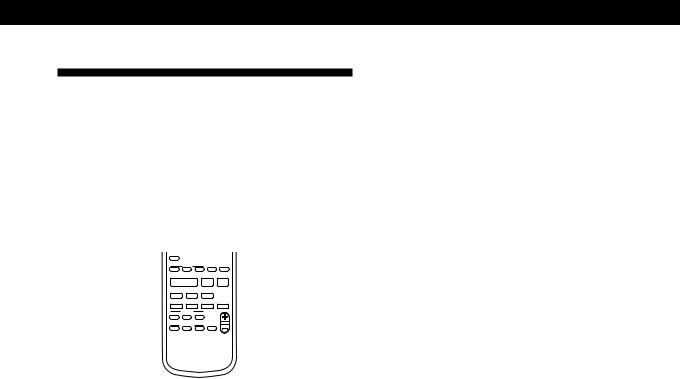
Recording on MDs
Recording the Current CD Track
(REC-IT Function) Z
This function lets you record a track on an MD while listening to a CD.
This function operates only when you connect a Sony CD player with a CONTROL A1 jack to the MD deck using a control A1 cable. For details of CONTROL A1 connections, see page 6.
REPEAT A˜B A.SPACE M.SCAN
/ >25 ? !
! (
( )
)
|
WRITE |
CLEAR P.HOLD |
NAME |
CHAR |
NUM |
· P p
REC-IT
= + r  REC-IT
REC-IT
T.REC MUSIC SYNC
0)
CD-SYNC
STOP START STANDBY
CD PLAYER |
FADER |
P= +
DIGITAL REC LEVEL /ANALOG OUT LEVEL
1Set the source selector on the amplifier to CD.
2Do Steps 2 to 5 in “Recording on an MD” on page 9 to prepare the deck for recording.
3Press ·on the CD player.
4Press REC-IT when you hear a track you want to record.
Play returns to the start of the track and recording starts. The MD deck stops at the end of the track, but CD playback continues from the next track.
To stop recording
Press pon the deck.
zThe deck copies CD text information as it is to the MD
When the current CD has CD text, the track titles are copied as the MD track titles.
zWhen “No Connect” appears in the display
Check the control A1 cable connection and make sure the CD player mode selector is set to CD1.
Notes
•The titles of the extremely short CD tracks may not be copied to the MD.
•Text information may not be copied for some CDs.
While “TOC Writing” is flashing
Do not move the deck or pull out the AC power cord to ensure the complete recording. The deck is currently updating the MD Table of Contents (TOC).
21EN
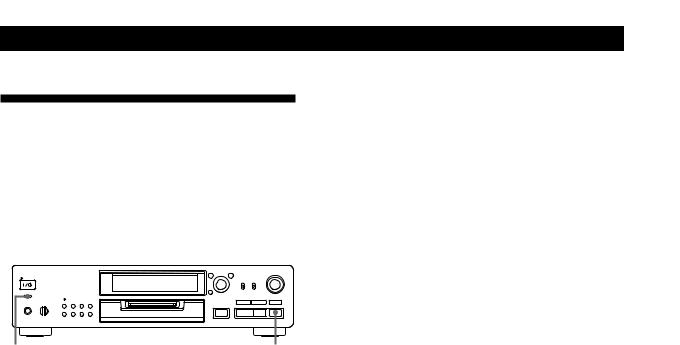
Recording on MDs
Recording on an MD Using a Timer
By connecting a timer (not supplied) to the deck, you can start and stop recording operations at specified times. For further information on connecting the timer and setting the starting and ending times, refer to the instructions that came with the timer.
|
0 |
) |
r |
§ |
· |
P |
p |
TIMER p
1Do Steps 1 to 7 in “Recording on an MD” on pages 9 and 10.
2• If you want to specify the time for the start of recording, press p.
•If you want to specify the time for the end of recording, do Steps 8 and 9 in “Recording on an MD” on page 10.
•If you want to specify the time for both start and end of recording, press p.
3Set TIMER on the deck to REC.
4Set the timer as required.
•When you have set the time for the start of recording, the deck turns off. When the specified time arrives, the deck turns on and starts recording.
•When you have set the time for the end of recording, recording continues. When the specified time arrives, the deck stops recording and turns off.
•When you have set the time for both the start and end of recording, the deck turns off. When the starting time arrives, the deck turns on and starts recording. When the ending time arrives, the deck stops recording and turns off.
5After you have finished using the timer, set TIMER on the deck to OFF. Then place the deck in standby status by plugging the AC power cord of the deck into a wall outlet or set the timer to continuous operation.
•If TIMER is left at REC, the deck will automatically start recording the next time you turn the deck on.
•If you do not change the deck to standby status for more than a week after timer recording has finished, the recorded contents may disappear.
Make sure to change the deck to standby status within a week after timer recording is completed
The TOC on the MD is updated and recorded contents are written to the MD when you turn the deck on. If the recorded contents have disappeared, “Standby” flashes when you turn the deck on.
Notes
•It may take about 30 seconds after the deck is turned on until recording starts. When recording at a specified time using the timer, be sure to take this time into account when setting the recording start time.
•During timer recording, new material is recorded from the end of the recorded portion on the MD.
•Material recorded during timer recording will be saved to the disc the next time you turn the deck on. “TOC” will flash in the display at that time. Do not move the deck or pull out the AC power cord while “TOC” is flashing.
•Timer recording will stop if the disc becomes full.
22EN
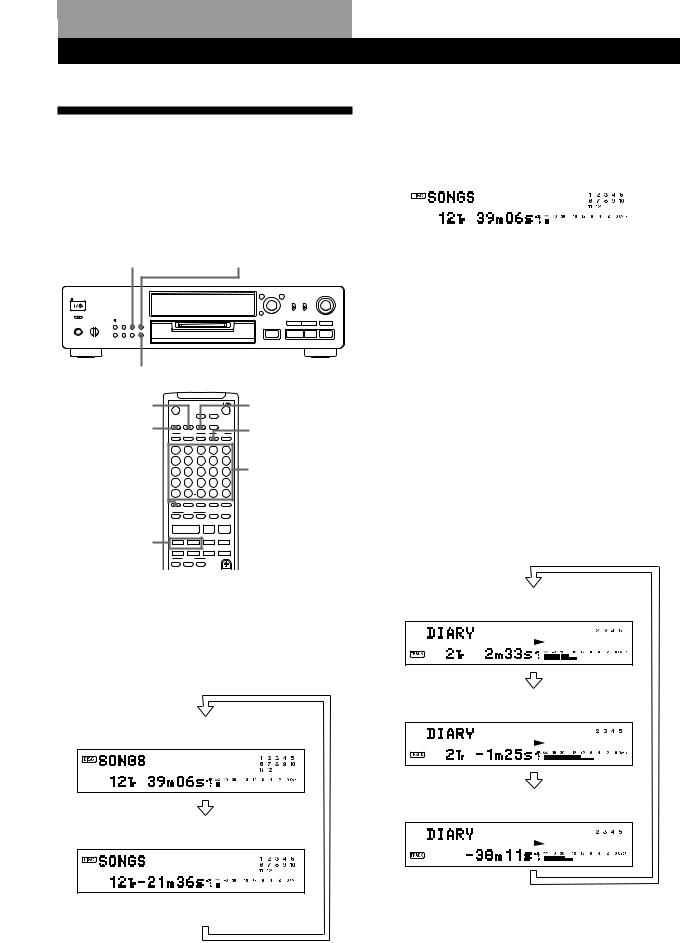
Playing MDs
Using the Display
You can use the display to check disc and track information such as the total track number, total playing time of the tracks, remaining recordable time of the disc, disc name, and the date when a track was recorded.
SCROLL/CLOCK SET |
DISPLAY/CHAR |
||
|
|
|
|
|
|
|
|
|
0 |
) |
r |
§ |
· |
P |
p |
TIME
SCROLL |
|
6 |
|
|
|
|
|
|
|
|
TIME |
|
|
EJECT |
|
|
|
|
|
|
|
|
|
|
|
|
|
|
MENU/NO |
YES |
|
|
DATE |
||
DISPLAY |
DISPLAY |
SCROLL |
|
TIME |
|
D.O BIT |
|
|
|||
|
|
PLAY MODE |
|
|
DATE |
RECORDED |
|||||
|
|
CONTINUE |
SHUFFLE |
PROGRAM RECORDED |
PRESENT |
||||||
|
A |
|
B |
|
C |
|
D |
|
E |
|
|
|
F |
1 |
G |
2 |
H |
3 |
I |
4 |
J |
5 |
|
|
K |
6 |
L |
7 |
M |
8 |
N |
9 |
O |
10 |
Number |
|
P |
11 |
Q |
12 |
R |
13 |
S |
14 |
T |
15 |
|
|
buttons |
||||||||||
|
U |
16 |
V |
17 W 18 |
X |
19 |
Y |
20 |
|||
|
Z |
21 |
– |
22 |
|
23 . |
24 |
, |
25 |
|
|
>25 |
|
>25 |
|
REPEAT |
|
A˜B A.SPACE |
M.SCAN |
|
|||
/ |
? |
|
! |
|
( |
|
) |
|
|
||
|
|
|
|
WRITE |
|
|
|
CLEAR |
|
P.HOLD |
|
|
|
NAME |
|
CHAR |
|
NUM |
|
|
|
|
|
·P p
=/+ |
= + r |
|
REC-IT |
|
T.REC MUSIC SYNC |
0)
CD-SYNC
STOP START STANDBY
Checking the total track number, total disc playing time and remaining recordable time of the disc
Each time you press TIME while the deck is stopped, you can change the display as follows:
Total track number and total playing time of all recorded tracks
Press
Remaining recordable time of the disc (Recorded MDs only)
The remaining recordable time of the disc is not shown for premastered MDs.
Press
Playing MDs
When you insert an MD, the disc name, total number of tracks, total disc playing time, and the music calender appear in the display as follows:
|
Disc name |
Music calendar |
|||||||||
|
|
|
|
|
|
|
|
|
|
|
|
|
|
|
|
|
|
|
|
|
|
|
|
|
|
|
|
|
|
|
|
|
|
|
|
|
|
|
|
|
|
|
|
|
|
|
|
|
|
|
|
|
|
|
|
|
|
|
|
Total number |
Total disc |
of tracks |
playing time |
A music calendar shows all the track numbers within a grid if the MD is a premastered disc, or without a grid if the MD is a recordable disc.
If the total track number exceeds 15, zappears to the right of number 15 in the music calendar.
Note
When you insert a new MD or turn off the deck and turn it on again, the last item displayed will reappear.
Checking the playing time, remaining time, and track number
Each time you press TIME while playing an MD, you can change the display as shown below. The track numbers in the music calendar disappear after they are played.
Track number and playing time of the current track
Press
Track number and remaining time of the current track
Press
Remaining time of all recorded tracks
Press
(Continued)
23EN
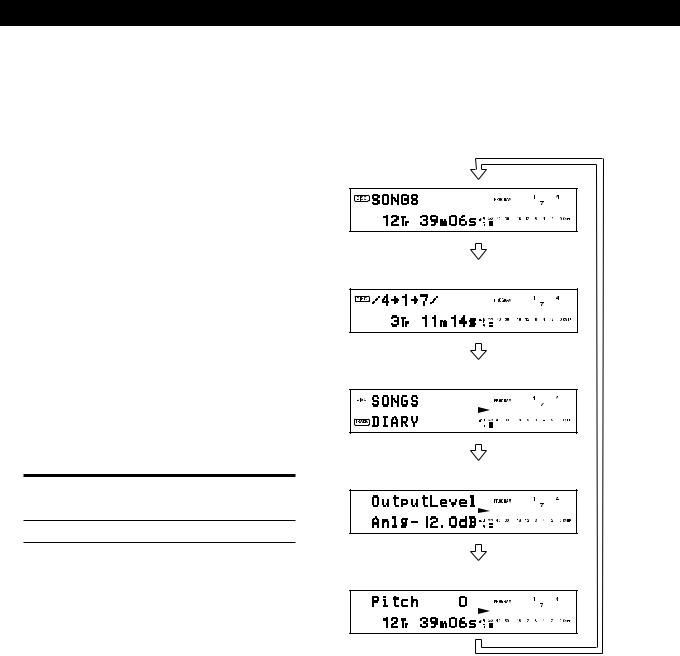
Playing MDs
zThe track name and disc name are displayed as follows:
The disc name appears whenever the deck is stopped, and the name of the current track appears when the track is playing. If no title is recorded, “No Name” appears instead of a title.
To label a recordable disc and its tracks, see “Labeling Recordings” on page 45.
zYou can scroll a title of more than 12 characters
Press SCROLL/CLOCK SET (or SCROLL). Since the display shows up to 11 characters at a time,
press SCROLL/CLOCK SET again to see the rest of the title if the title has 12 characters or more.
Press SCROLL/CLOCK SET again to pause scrolling, and again to continue scrolling.
Displaying the recording date Z
When the internal clock has been set, the deck automatically records the recording date and time of all recordings. You can then check the recording date and time of a track.
Changing the display
Each time you press DISPLAY/CHAR (or DISPLAY) while the deck is stopped or playing, you can change the display as follows:
Normal display
Press
The contents of a program (only when “PROGRAM” lights up)
Press
Title (Disc name and track name)
1Locate the track for which you want to check the recording date and time.
When the deck is |
Press |
|
|
stopped |
=or + |
playing or on play pause =, +, or number buttons
2Press DATE RECORDED.
“No Date” appears if the internal clock has not been set or the track was recorded on another MD deck without a date and time stamp function.
Press
Output level (The recording level is displayed while the deck is stopped.)
Press
Pitch display
Press
24EN
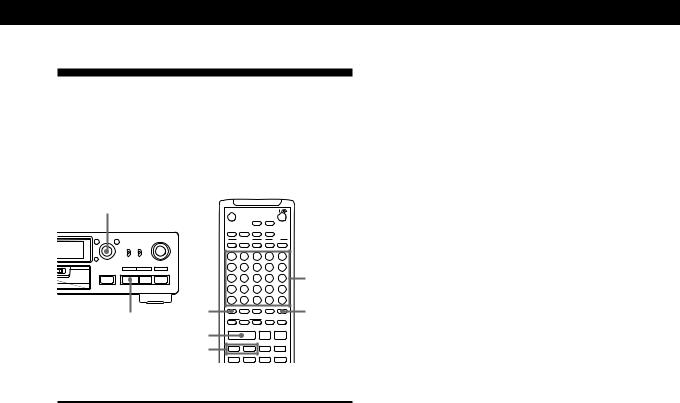
Locating a Specific Track
You can quickly locate any track while playing a disc by using the AMS (Automatic Music Sensor) control, =and +buttons, number buttons, or M.SCAN button on the remote.
AMS ±
EJECT
6
MENU/NO YES
0 ) r
§ |
· P p |
>25
·
·
=/+
|
DISPLAY |
|
SCROLL |
|
TIME |
|
D.O BIT |
|
|
|
|
|
PLAY MODE |
|
|
|
DATE |
|
|||
|
CONTINUE |
|
SHUFFLE |
PROGRAM RECORDED |
PRESENT |
|
||||
A |
|
B |
|
C |
|
D |
|
E |
|
|
F |
1 |
G |
2 |
H |
3 |
I |
4 |
J |
5 |
|
K |
6 |
L |
7 |
M |
8 |
N |
9 |
O |
10 |
Number |
P |
11 |
Q |
12 |
R |
13 |
S |
14 |
T |
15 |
|
U |
16 |
V |
17 W 18 |
X |
19 |
Y |
20 |
buttons |
||
Z |
21 |
– |
22 |
|
23 |
. |
24 |
, |
25 |
|
|
>25 |
|
REPEAT |
|
A˜B |
A.SPACE |
M.SCAN |
M.SCAN |
||
/ |
? |
|
! |
|
( |
|
) |
|
||
|
|
|
WRITE |
|
|
|
CLEAR |
P.HOLD |
|
|
|
NAME |
|
CHAR |
|
NUM |
|
|
|
|
|
|
|
· |
|
|
P |
|
p |
|
||
|
|
|
|
|
|
|
|
REC-IT |
|
|
|
= |
|
+ |
|
r |
|
|
|
||
|
|
|
|
|
|
T.REC |
MUSIC SYNC |
|
||
|
0 |
|
) |
|
|
|
|
|
|
|
To locate |
Do the following: |
|
|
|
|
The next or succeeding |
During playback, turn AMS clockwise |
|
tracks |
(or press + repeatedly) until you |
|
|
find the track. |
|
The current or |
During playback, turn AMS |
|
preceding tracks |
counterclockwise (or press = |
|
|
repeatedly) until you find the track. |
|
|
|
|
A specific track |
Press number buttons to enter the |
|
directly Z |
track number. |
|
|
|
|
A specific track by |
1 |
Turn AMS until the track number |
using AMS |
|
you want to locate appears while |
|
|
the deck is stopped. (The track |
|
|
number is flashing.) |
|
2 |
Press AMS or ·. |
|
|
|
By scanning each track |
1 |
Press M.SCAN before you start |
for 6 seconds (music |
|
playing. |
scan) Z |
2 |
When you find the track you want, |
|
|
press ·to start playing. |
|
|
|
zWhen you directly locate a track with a number over 25 Z
You must press >25 first, before entering the corresponding digits.
Press >25 once if it is a 2-digit track number, and twice if it is a 3-digit track number.
To enter “0”, press button 10. Examples: • To play track number 30
Press >25 once, then 3 and 10.
•To play track number 100
Press >25 twice, then 1, 10 and 10.
Playing MDs
zYou can extend the playing time during music scan
1While the deck is stopped, press MENU/NO twice to display “Setup Menu”.
2Turn AMS to select “Setup 07”, then press AMS.
3Turn AMS to select the playing time within a range of 6 to 20 seconds (in 1 second steps), then press AMS.
4Press MENU/NO.
zTo pause playing at the beginning of a track
Turn AMS (or press= or +) after pausing playback.
zTo go quickly to the beginning of the last track
Turn AMS counterclockwise (or press=) while the display shows the total track number, total disc playing time or remaining recordable time of the disc (recordable disc only), or disc name (see page 23).
25EN
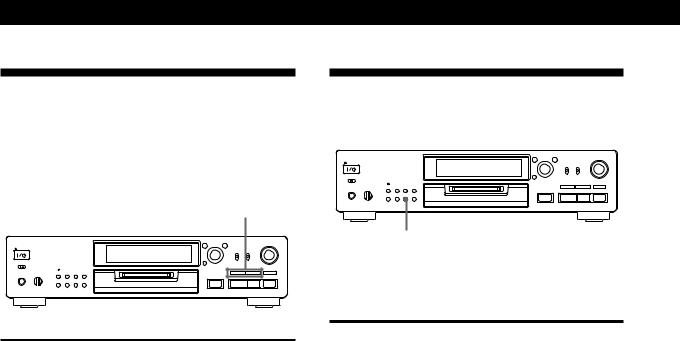
Playing MDs
Locating a Particular Point in a
Track
You can also use the 0and )buttons to locate a particular point in a track during playback or playback pause.
0/)
0 |
) |
r |
§ |
· P p |
To locate a point |
Press |
|
|
While monitoring the |
)(forward) or 0(backward) and |
sound |
keep pressing until you find the point. |
|
|
Quickly by observing |
)or 0and keep pressing until |
the display during |
you find the point. There is no sound |
playback pause |
output during this operation. |
|
|
zIf “—Over—” appears while you are pressing ) during playback pause
The disc has reached to its end. Press0 (or =) or turn AMS counterclockwise to go back.
Notes
•If the disc reaches the end while you are pressing) during sound monitoring, the deck stops.
•Tracks that are only a few seconds long may be too short to scan using the search function. For such tracks, it is better to play the MD at normal speed.
Playing Tracks Repeatedly
You can play tracks repeatedly in any play mode.
|
0 |
) |
r |
§ |
· |
P |
p |
REPEAT
Press REPEAT.
“REPEAT” appears in the display. The deck repeats the tracks as follows:
When the MD is played in |
The deck repeats |
|
|
Normal play (page 11) |
All the tracks |
|
|
Shuffle Play (page 27) |
All the tracks in random order |
|
|
Program Play (page 28) |
The same program |
|
|
To cancel repeat play
Press REPEAT several times until “REPEAT” disappears.
The deck returns to the original playing mode.
Repeating the current track
While the track you want to repeat is playing in normal, Shuffle, or Program Play, press REPEAT several times until “REPEAT 1” appears in the display.
26EN

Repeating a specific portion (A-B Repeat)
Z
You can play a specific portion of a track repeatedly. This might be useful when you want to memorize lyrics. Note that you can only repeat a portion within the boundaries of a single track.
EJECT
6
|
|
|
|
MENU/NO |
|
YES |
|
|
|
|
DISPLAY |
|
SCROLL |
|
TIME |
|
D.O BIT |
|
|
|
|
|
|
PLAY MODE |
|
|
DATE |
|
||||
|
CONTINUE |
|
SHUFFLE |
PROGRAM |
RECORDED |
|
PRESENT |
|
||
A |
|
B |
|
C |
|
D |
|
E |
|
|
F |
1 |
G |
2 |
H |
3 |
I |
4 |
J |
5 |
|
K |
6 |
L |
7 |
M |
8 |
N |
9 |
O |
10 |
|
P |
11 |
Q |
12 |
R |
13 |
S |
14 |
T |
15 |
|
U |
16 |
V |
17 W 18 |
X |
19 |
Y |
20 |
|
||
Z |
21 |
– |
22 |
|
23 |
. |
24 |
, |
25 |
|
REPEAT |
>25 |
|
REPEAT |
|
A˜B |
A.SPACE |
|
M.SCAN |
|
|
/ |
? |
|
! |
|
( |
|
) |
|
CLEAR |
|
|
|
|
WRITE |
|
|
|
CLEAR |
|
P.HOLD |
|
A˜B |
NAME |
·CHAR |
|
NUM |
P |
|
p |
p |
||
|
|
|
|
|
|
|
|
REC-IT |
||
|
|
|
|
|
|
|
|
|
||
) |
= |
|
+ |
|
r |
|
|
|
||
0 |
|
) |
T.REC MUSIC SYNC |
|
||||||
|
|
CD-SYNC |
|
|
|
|
|
|
|
|
|
STOP |
|
START |
STANDBY |
|
|
|
|
|
|
|
|
CD PLAYER |
|
|
FADER |
|
|
|
||
P= + 

1While playing a disc, press A˜B at the starting point (point A) of the portion to be played repeatedly.
“REPEAT A-” appears and “B” flashes in the display.
2Continue playing the track or press ) until you reach the ending point (point B), then press A˜B
again.
“REPEAT A-B” lights continuously. The deck starts to play the specified portion repeatedly.
To cancel A-B Repeat
Press REPEAT, CLEAR or p.
Setting new starting and ending points
You can repeat the portion immediately after the currently specified portion by changing the starting and ending points.
1Press A˜B while “REPEAT A-B” appears. The current ending point B becomes the new
starting point A, “REPEAT A-” lights continuously, and “B” flashes in the display.
2Continue playing the track or press ) until you
reach the new ending point (point B), then press A˜B again.
“REPEAT A-B” lights continuously and the deck starts playing repeatedly the newly specified portion.
Playing MDs
Playing in Random Order
(Shuffle Play)
You can have the deck “shuffle” tracks and play them in random order.
|
0 |
) |
r |
§ |
· |
P |
p |
PLAY MODE ·
1Press PLAY MODE repeatedly (or SHUFFLE once) until “SHUFFLE” appears in the display when the deck is stopped.
2Press · to start Shuffle Play.
“—Shuffle—” and “J” appear in the display while the deck is “shuffling” the tracks.
To cancel Shuffle Play
Press PLAY MODE repeatedly (or CONTINUE once) when the deck is stopped until “SHUFFLE” disappears.
zYou can specify tracks during Shuffle Play
•To play the next track, turn AMS clockwise (or press +).
•To play from the beginning of the current track again, turn AMS counterclockwise (or press=). You cannot use AMS (or=) to go to tracks that have already been played.
27EN

Playing MDs
Creating Your Own Program
(Program Play)
You can specify the playback order of the tracks on an MD and create your own programs containing up to 25 tracks.
DISPLAY/CHAR MENU/NO YES 0/)
0 |
) |
r |
|
|
|
|
|
|
|
|
|
|
|
§ · P p |
PLAY MODE |
|
|
|
|
|
|
AMS ± · |
||||
|
|
EJECT |
|
|
|
|
|
|
|
|
MENU/NO |
|
|
6 |
|
|
MENU/NO |
YES |
|
|
YES |
||
DISPLAY |
|
|
PLAY MODE |
TIME |
|
DATE |
|
||||
|
DISPLAY |
SCROLL |
|
D.O BIT |
|
|
PROGRAM |
||||
|
|
CONTINUE |
SHUFFLE PROGRAM RECORDED |
PRESENT |
|||||||
|
A |
|
B |
|
C |
|
D |
|
E |
|
|
|
F |
1 |
G |
2 |
H |
3 |
I |
4 |
J |
5 |
|
|
K |
6 |
L |
7 |
M |
8 |
N |
9 |
O |
10 |
Number |
|
P |
11 |
Q |
12 |
R |
13 |
S |
14 |
T |
15 |
|
|
U |
16 |
V |
17 W 18 |
X |
19 |
Y |
20 |
buttons |
||
|
Z |
21 |
– |
22 |
|
23 . |
24 |
, |
25 |
|
|
>25 |
|
>25 |
|
REPEAT |
A˜B A.SPACE |
M.SCAN |
|
||||
/ |
? |
|
! |
|
( |
|
) |
|
|
||
|
|
|
|
WRITE |
|
|
|
CLEAR |
|
P.HOLD |
|
|
|
NAME |
|
CHAR |
|
NUM |
|
|
|
|
CLEAR |
· |
|
|
· |
|
|
P |
|
p |
|||
|
|
|
|
|
|
||||||
REC-IT
=+ r
0/) |
|
T.REC MUSIC SYNC |
0 |
) |
|
|
CD-SYNC |
|
|
STOP |
START STANDBY |
1While the deck is stopped, press MENU/NO twice to display “Setup Menu”.
2Turn AMS to display “Program ?”, then press AMS (or YES).
3Do either a) or b):
a)When using the controls on the deck
1Turn AMS until the track number you want appears in the display.
2Press AMS.
If you enter the wrong track number
Press 0or )until the wrong track number flashes, turn AMS to set the correct track number, then press AMS.
If “0” flashes, press 0.
b)When using the remote
Press the number buttons to enter the tracks you want to program in the order you want. To program a track with a number over 25, use the >25 button (see page 25).
If you enter the wrong track number
Press 0or )until the wrong track number flashes, then enter the correct track number
with the number buttons. If “0” flashes, press 0.
4Repeat Step 3 to enter other tracks.
The entered track is added to the location where the “0” flashes.
Each time you enter a track, the total program time is added up and appears in the display.
5After finishing programming, press YES. “Complete!!” appears and programming is completed.
6Press PLAY MODE repeatedly (or PROGRAM once) until “PROGRAM” appears in the display.
7Press · to start Program Play.
To cancel Program Play
Press PLAY MODE repeatedly (or CONTINUE once) when the deck is stopped until “PROGRAM” disappears.
zThe program remains even after Program Play ends
When you press·, you can play the same program again.
Notes
•The display shows “- -m - -s” instead of the total playing time when the total playing time of the program exceeds 199 minutes.
•“ProgramFull” appears when you program over 25 tracks. Erase the unnecessary tracks to enter other tracks.
28EN
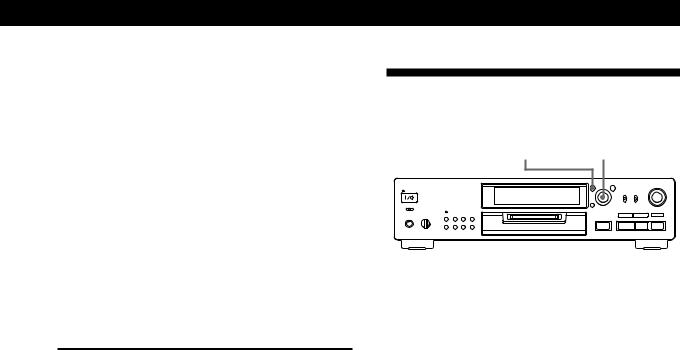
Checking the track order
While the deck is stopped and “PROGRAM” is on, press DISPLAY/CHAR (or DISPLAY) several times. The track numbers appear in the order they were programmed as follow:
“/3 /5 /8 /1 /2/”
To check the rest of the track order
Turn AMS.
You can scroll the display to check all the track numbers you programmed.
Playing MDs
Useful Tips When Recording From MDs to Tape
MENU/NO AMS ±
0 ) r
§ |
· P p |
Changing the track order
You can change the order of the tracks in your program before you start playing.
To |
|
Do the following procedure |
|
|
|
after Steps 1 and 2 in |
|
|
|
“Creating Your Own |
|
|
|
Program”: |
|
|
|
|
|
Erase |
a track |
Press 0or )until the track |
|
|
|
number you want to erase |
|
|
|
flashes, then press CLEAR. |
|
|
|
|
|
|
the whole |
Keep pressing CLEAR until all |
|
|
program |
programmed track numbers |
|
|
|
disappear. |
|
|
|
|
|
Add a |
to the |
1 |
Press 0until “0” flashes at |
track |
beginning of |
|
the left of the first track. |
|
the program |
2 |
Do Steps 3 to 5 on page 28. |
|
|
|
|
|
in the middle |
1 |
Press 0or )until the |
|
of the program |
|
track which precedes the track |
|
|
2 |
to be added flashes. |
|
|
Press AMS so that “0” flashes, |
|
|
|
|
then do Steps 3 to 5 on page |
|
|
|
28. |
|
|
|
|
|
to the end of |
1 |
Press 0until “0” flashes at |
|
the program |
2 |
the right of the last track. |
|
|
Do Steps 3 to 5 on page 28. |
|
|
|
|
|
Change a track in the |
1 |
Press 0or )until the |
|
program |
|
|
track number you want to |
|
|
2 |
change flashes. |
|
|
Do Steps 3 to 5 on page 28. |
|
|
|
|
|
Inserting blank spaces while recording to tape (Auto Space)
The Auto Space Function inserts a 3-second blank space between each track while recording from MDs to tapes, allowing you to use the AMS function during later playback.
1While the deck is stopped, press MENU/NO twice to display “Setup Menu”.
2Turn AMS to select “Setup 04”, then press AMS.
3Turn AMS to select “Auto Space”, then press AMS.
4Press MENU/NO.
zYou can turn on the Auto Space Function using the remote Z
While the deck is stopped, press A.SPACE repeatedly until “Auto Space” appears in the display.
To cancel Auto Space
Cancelling the function through menu operation on the deck
1 Do Steps 1 and 2 in “Inserting blank spaces while recording to tape” on this page.
2 Turn AMS to select “Auto Off”, then press AMS. 3 Press MENU/NO.
Cancelling the function using the remote Z
While the deck is stopped, ressp A.SPACE repeatedly until “Auto Off” appears.
Note
If the Auto Space Function is on while recording a selection containing multiple track numbers, (for example, a medley or symphony), blank spaces will be inserted within the selection whenever the track number changes.
(Continued)
29EN

Playing MDs
Pausing after each track (Auto Pause)
When the Auto Pause Function is on, the deck pauses after playing each track. Auto Pause is convenient when recording single tracks or multiple, nonconsecutive tracks.
Select “Auto Pause” instead of “Auto Space” in Step 3 on “Inserting blank spaces while recording to tape” on page 29.
zYou can turn on the Auto Pause Function using the remote Z
While the deck is stopped, press A.SPACE repeatedly until “Auto Pause” appears in the display.
To restart playback
Press · or P.
To cancel Auto Pause
Fading In and Out (Fader)
You can gradually increase the playback level of the signal output to the LINE (ANALOG ) OUT jacks and the PHONES jack at the beginning of a playback (fadein playback) or gradually decrease the playback level at the end of a playback (fade-out playback).
This function is convenient when, for example, you want to start or end playback in the middle of the track.
Z |
21 |
– |
22 |
23 |
. 24 |
, 25 |
|
>25 |
|
REPEAT |
A˜B |
A.SPACE |
M.SCAN |
/ |
? |
! |
|
( |
) |
|
|
|
|
WRITE |
|
CLEAR |
P.HOLD |
|
NAME |
|
CHAR |
NUM |
|
|
|
|
· |
|
P |
p |
|
|
|
|
|
|
|
REC-IT |
|
= |
|
+ |
|
r |
|
|
|
|
|
|
T.REC MUSIC SYNC |
|
|
0 |
|
) |
|
|
|
|
|
CD-SYNC |
|
|
|
|
|
STOP |
|
START STANDBY |
|
||
|
|
CD PLAYER |
|
FADER |
|
|
|
P |
|
= + |
|
|
|
DIGITAL REC LEVEL |
FADER |
/ANALOG OUT LEVEL |
FADER
Cancelling the function through a menu operation on the deck
Do Steps 1 to 3 in “To cancel Auto Space” on page 29.
Cancelling the function using the remote Z
While the deck is stopped, press A.SPACE repeatedly until “Auto Off” appears.
Note
If you turn off the deck or disconnect the AC power cord, the deck will recall the last setting of the Auto Space and Auto Pause Functions the next time you turn on the deck.
Fade-in playback
During playback pause, press FADER at the position where you want fade-in playback to start.
Zin “Fade Z3.2s” flashes and the deck performs fadein playback until the counter reaches to “0.0s”.
Fade-out playback
During playback, press FADER at the position where you want fade-out playback to start.
zin “Fade z3.2s” flashes and the deck performs fadeout playback until the counter reaches “0.0s”.
The deck changes to playback pause when fade-out playback finishes.
Note
The signal level output to the digital output connector does not change.
zYou can set the duration of fade-in and fade-out playback independently
Do Steps 1 to 5 in “You can set the duration of the fadein and fade-out recording independently” on page 20.
30EN
